Oh our beloved Chis, the tiniest of them all!
History of the modern Chihuahua dog dates back to the 19th century. However, the Chi we know today developed from a small dog that’s called Techichi, and that was way back in the 9th century AD. Even though Techichi was a wild dog, the Toltec people managed to domesticate them.
As time went by, Techichi dogs went extinct and the Chihuahua dogs came to the spotlight.
Through years of selective breeding, Chis developed their unique appearance. Besides their funky personalities, paw lovers quickly fell in love with different Chihuahua colors. And it’s no wonder they did!
Chihuahua colors are a little bit different from other dog colors. Among all mexican dog breeds, Chihuahua dogs developed the biggest number of different coat colors.
This article is a fun guide to Chihuahua colors, with pictures and simple information about the various coat colors and lengths.
Stick around to find out more!
How Many Colors Does A Chihuahua Have?
There are many colors of the Chihuahua dog, which means that they can be camouflaged in many different environments. Most colors are a combination of the colors of their purebred Chi parents.
In this article we are showing you a total of 43 Chihuahua colors along with their distinct markings and patterns. But it is important to note that not all colors of the same shade will look alike.
So, there can be many more colors of this tiny dog.
Different Chihuahua mixes, like the Chihuahua Corgi mix, inherit a wider gene pool which equals more coat colors! But, today we want to focus on purebred Chihuahua colors.
What Are The Most Common Colors Of Chihuahuas?
Chihuahuas come in a variety of coat colors, but the most common are chocolate, red, fawn, and cream. Some come in parti color combinations!
Additionally, a dense, sleek black-and-tan Chi color, with a patterned white chest, belly, and face became very popular.
Chihuahuas come in all sorts of coat colors, but some are more common than others.
Standard Chihuahua Colors
There are so many Chihuahua colors which can be confusing. To make things easier, the American Kennel Club has put up the official breed standard for the purebred Chihuahua dog. The standard states that any Chi color is allowed, as long as it is either solid, marked or splashed.
So, if you want to breed your dog, choosing a unique standard Chihuahua color is a way to go. If you want your Chihuahua dog to be a show dog, then it is important you choose one of the standard Chihuahua colors.
There are some pretty unique and interesting standard Chihuahua colors that you will love!
1. Black

Photo from: @ivyandremi
Most Chihuahuas inherit solid black coats but they are usually backed with different colored markings. Now we are talking about a solid black (without any markings) Chi coat color that is extremely rare.
To be born completely black in color, a solid black Chihuahua puppy must have purebred Chi parents with dominant black genes.
A black Chihuahua‘s muzzle and eyes are colored in solid black.
2. Black & Tan
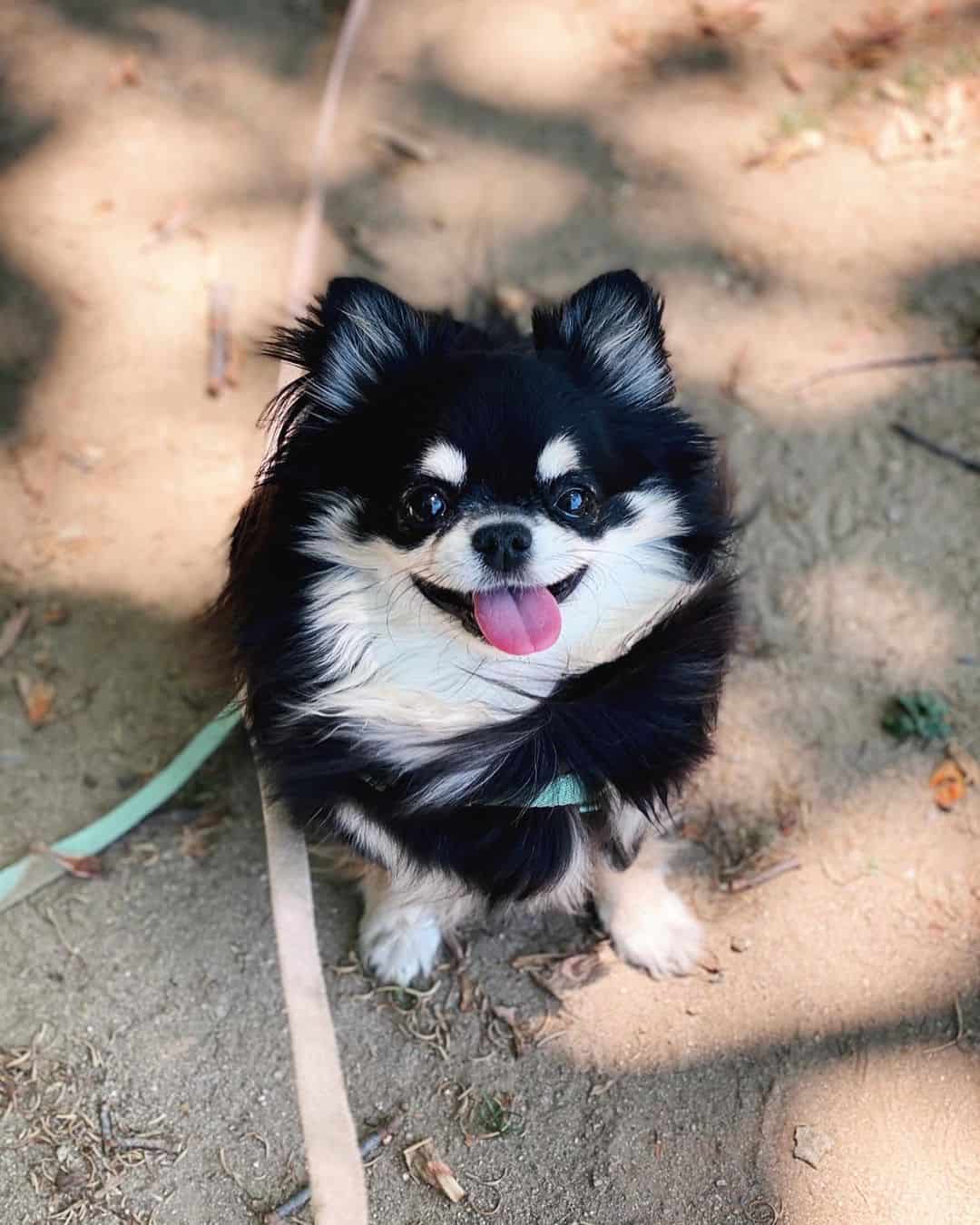
Photo from: @hello_kong_yi
But, what makes a black and tan Chihuahua special is that it often inherits a signature white marking that is located on the chest.
So, while its muzzle, ears, and legs are colored in tan, Chi’s chest is usually white.
3. Blue & Tan
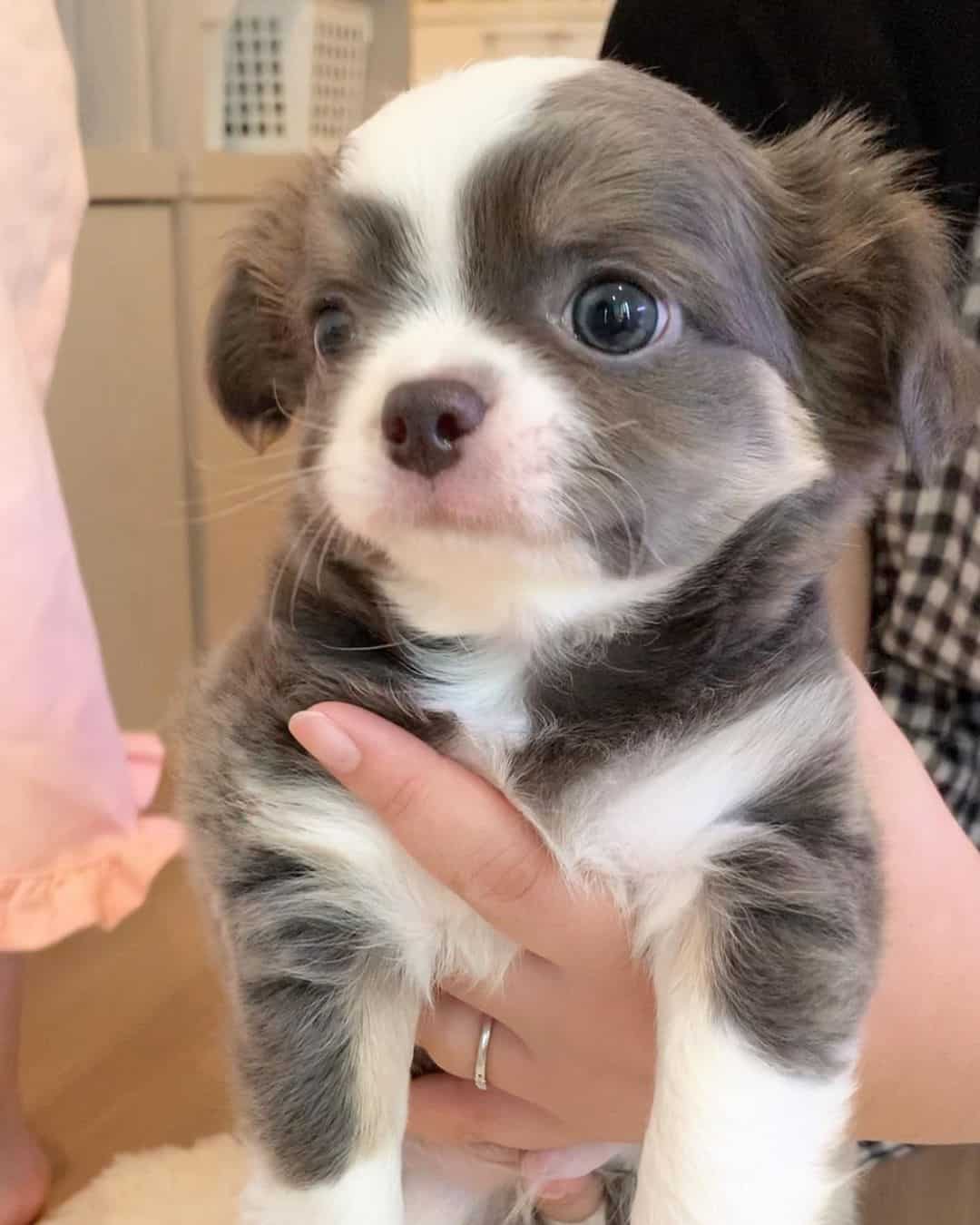
Photo from: @lala_noah_87
We are back to yet another rare Chi coat color. Despite the fact that blue and tan coloring isn’t something you’ll see everyday, this color combination is welcomed to the American Kennel Club.
If you are familiar with dog colors, you know that blue coat color doesn’t actually come off as blue. The “blue” coat color derives from a diluted black pigment.
That being said, blue and tan Chi need both the dilution gene and the gene responsible for tan markings.
Typically, the paws, the area around the muzzle, and the tips of the ears are all tan in hue.
4. Chocolate
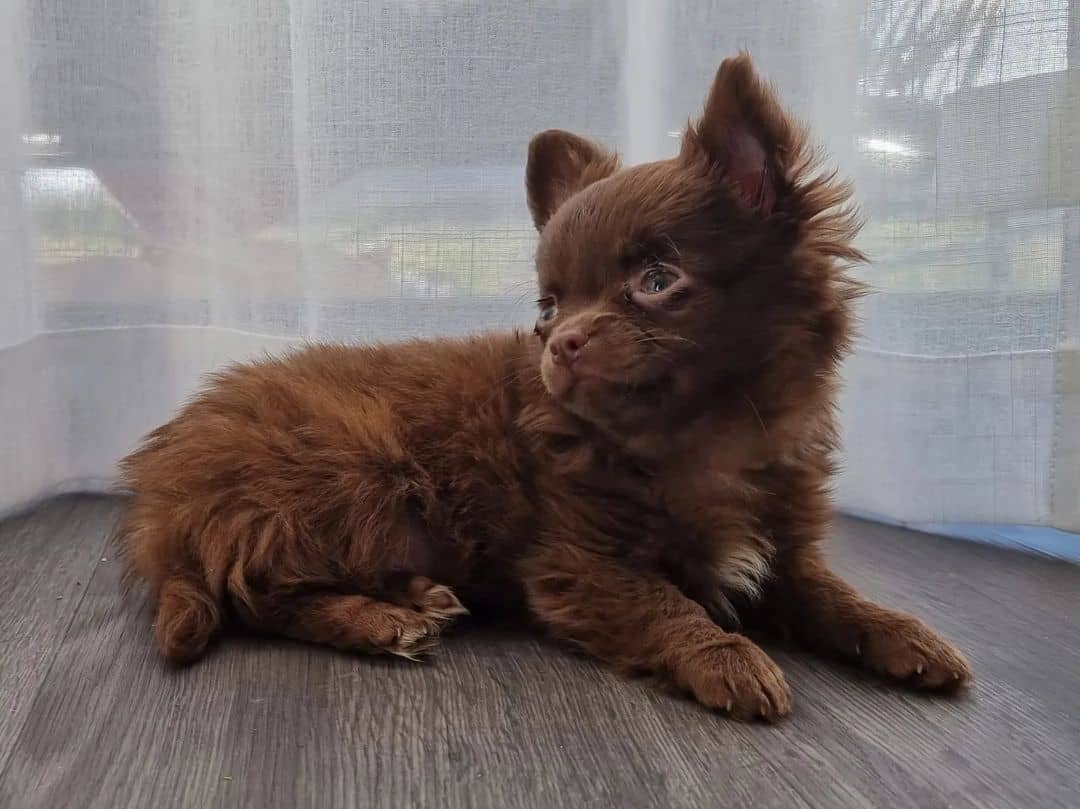
Photo from: @bludiamond_chi
Unlike their solid black counterparts, chocolate Chihuahuas are not as uncommon.
The chocolate Chihuahua dog inherits a dark base coat color that has been lightened to chocolate brown. Alongside that, the skin around its nose and eyelids has also lightened to a chocolate shade.
The chocolate color doesn’t appear in many dog breeds. The most popular breeds inheriting this color are Labrador Retrievers and the Havanese.
5. Chocolate & Tan
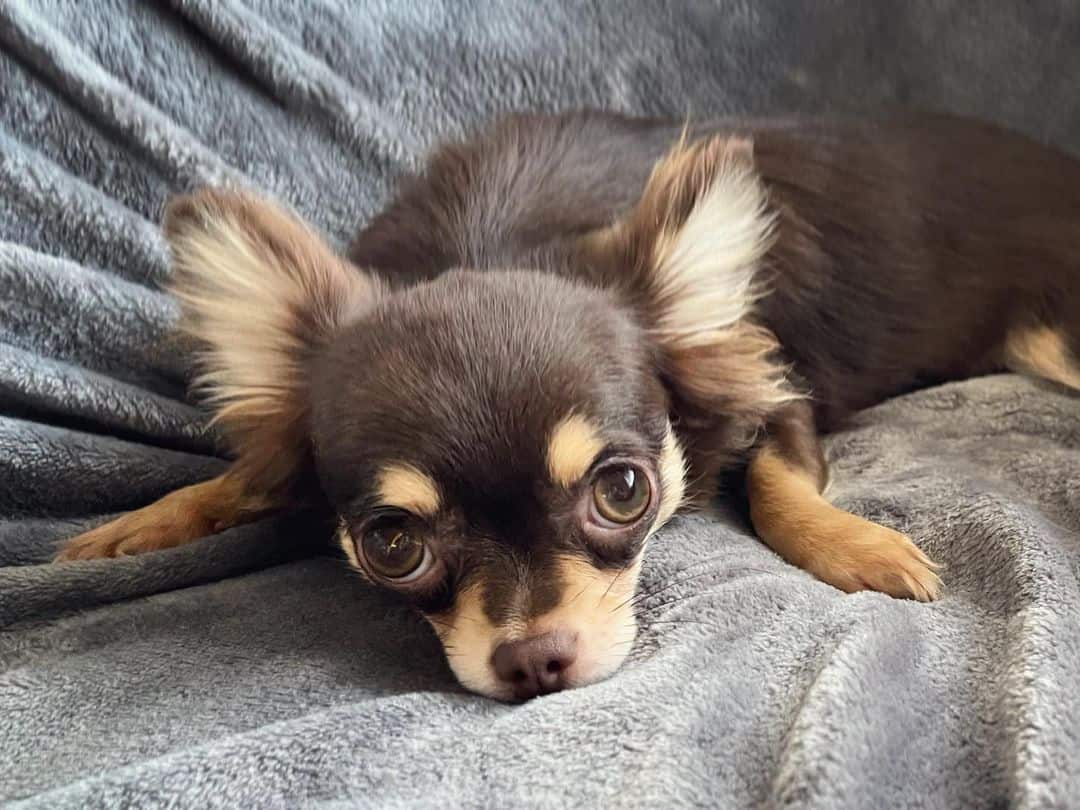
Photo from: @eveana_chihuahuas
We usually see black and tan dogs, but chocolate and tan is a rarer color combination.
The chocolate color is caused by the previously mentioned black pigment that is diluted. This means that chocolate & tan Chihuahuas inherit brown or beige noses.
Inheriting tan sports also known as “kiss markings” above their eyes makes chocolate and tan Chis ultra cute!
Besides tanned kiss markings, chocolate Chihuahuas have tan markings across their chest, muzzle, and legs.
6. Cream
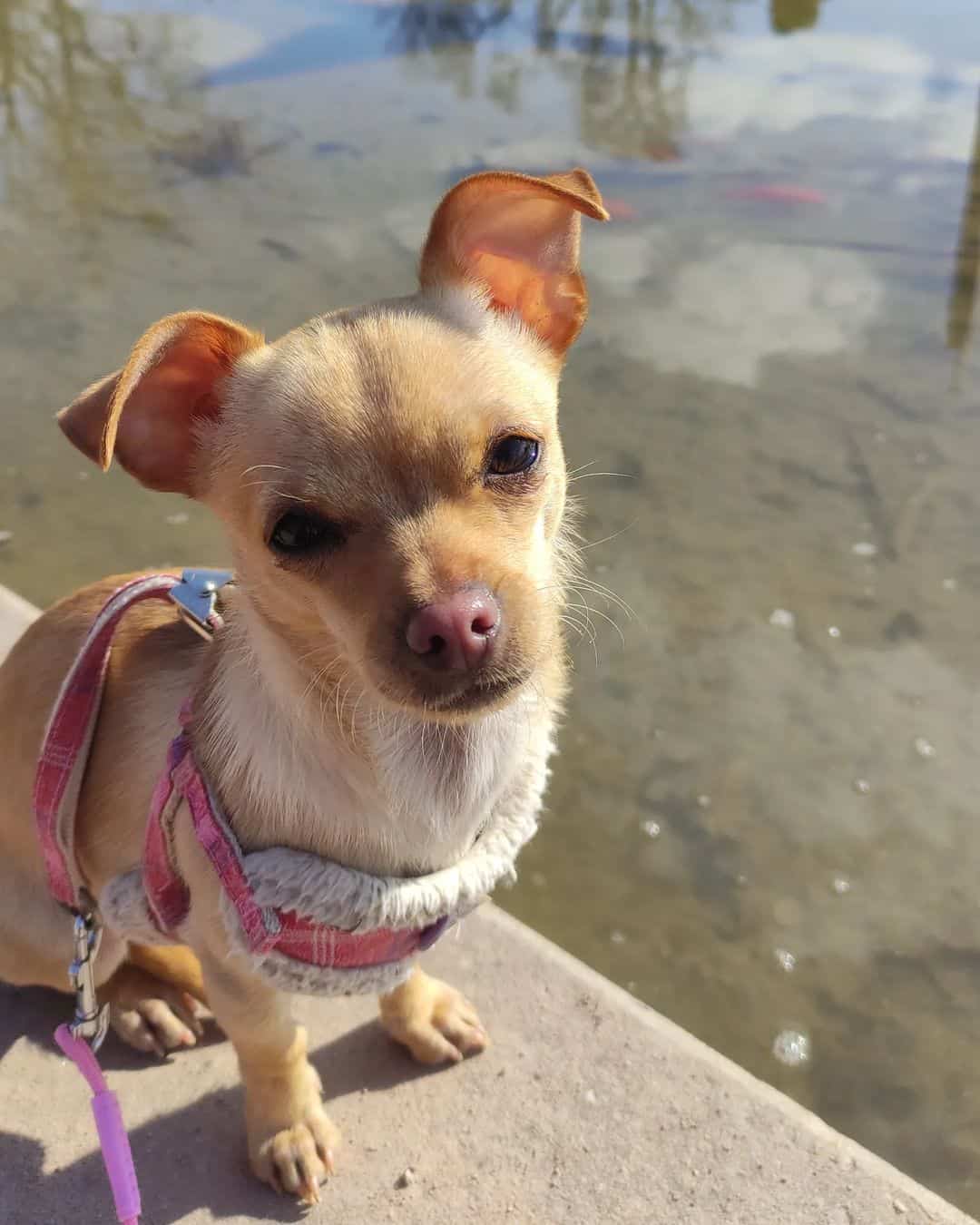
Photo from: @cocoxgoofy
This is because Chi’s cream color derives from the pheomelanin pigment that is responsible for the dilution of red color.
Similar to cream Shiba Inus, cream Chis can have almost completely white coats, but once you take a closer look you see that the coat color leans more towards diluted red shades.
In addition to light creamy coats, most cream Chihuahuas inherit lighter skin pigmentation. They usually have dark brown to black colored eyes and noses.
7. Fawn
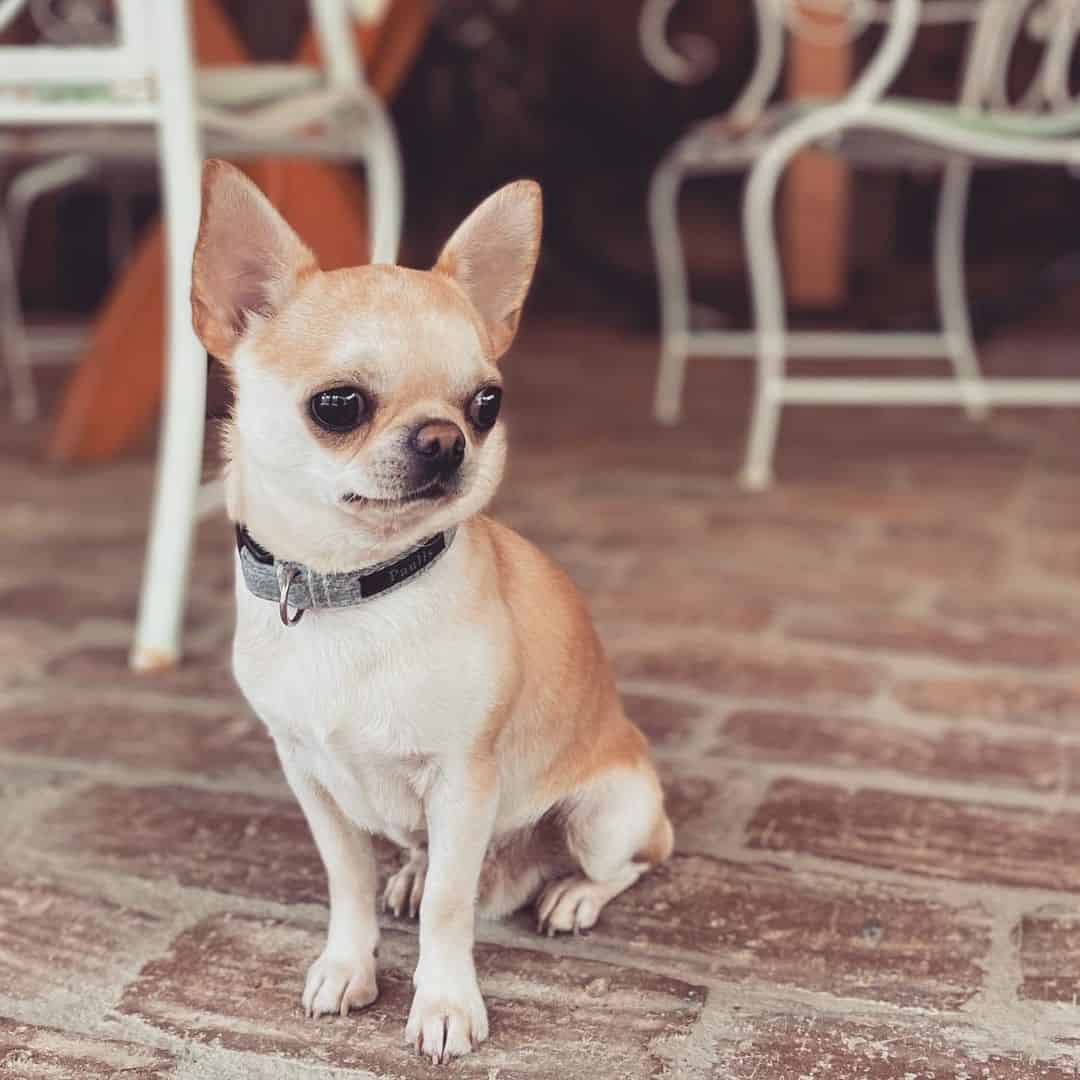
Photo from:@findus.and.friends
Having said that, the fawn coat color of a Chihuahua puppy is dominant and it looks yellowish. But, it is not dull.
Fawn Chihuahuas come in different shades. Their fawn color can range from a lighter cream-yellow to a darker red-yellow. This depends on coat color genetics.
8. Fawn & White
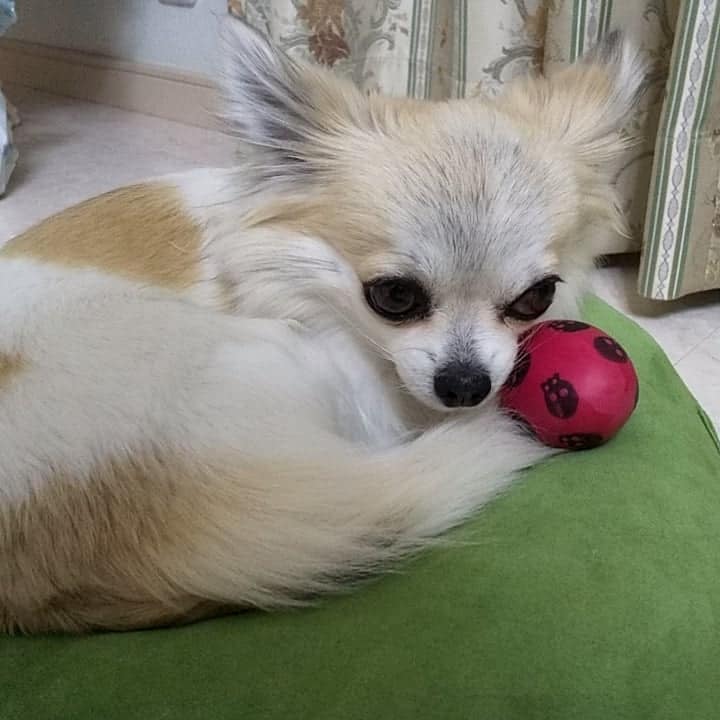
Photo from: @happyblacknwhite
The highest concentration of white coat color is across the Chihuahua’s chest. It spreads down towards Chi’s legs and paws, and up towards its muzzle and around the eyes. White markings can also be present on the Fawn Chihuahuas tummy.
Fawn and white is present in Australian Shepherd coat colors, as well as Pitbulls, Beligan Malinoises, Pugs, and French Bulldogs.
9. Red
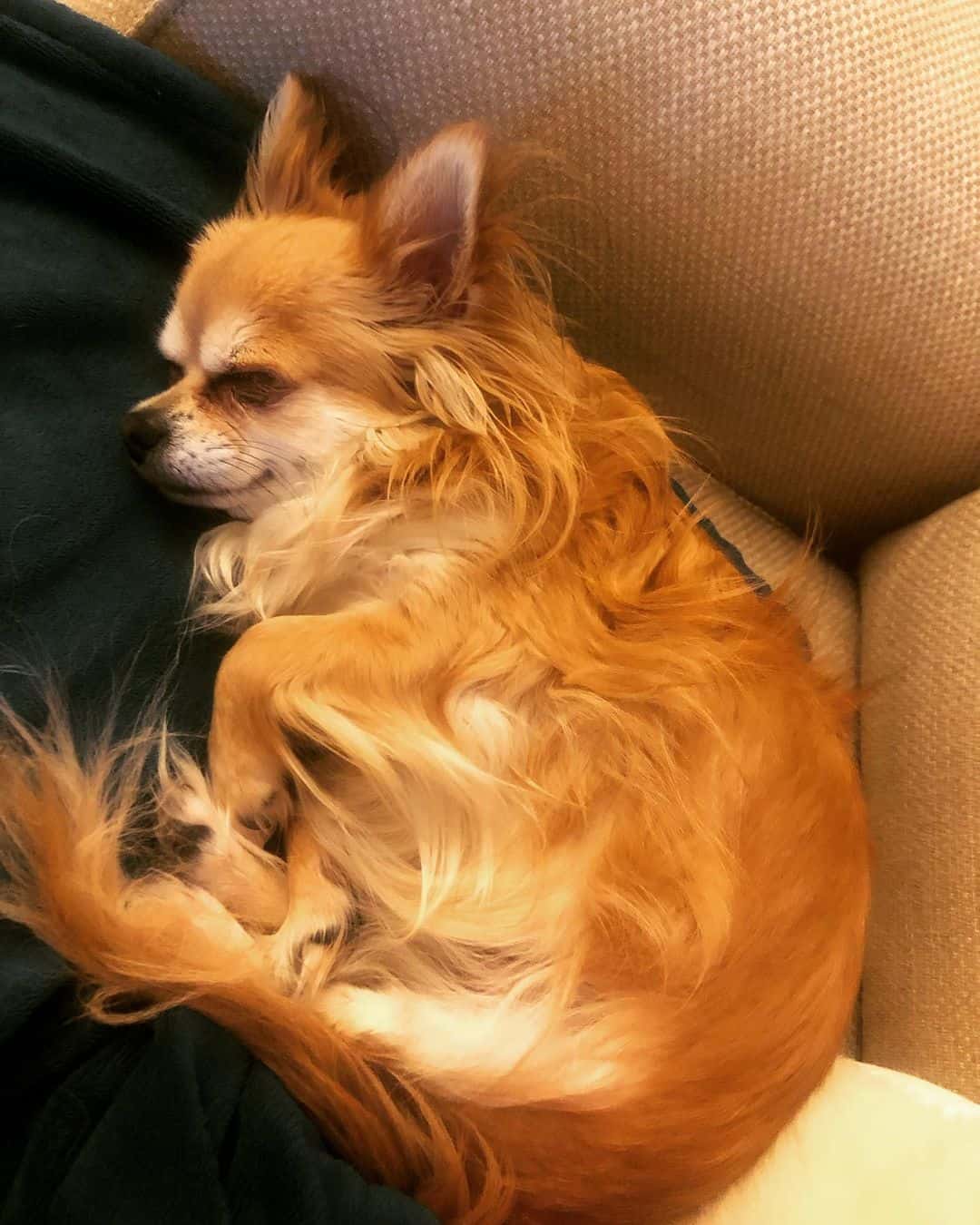
Photo from: @natasha_bimba_rudge
Red is quite a common coat color in the Chihuahua breed. It also derives from a pheomelanin red pigment that can range from darker to lighter shades.
Having said that, the red pigment can appear as deep red that leans towards a darker shade of orange. Or it can be on the brownish side with chestnut or tanned hues.
Depending on the red gene intensity, red Chis can inherit either black or brown noses.
Alternate Chihuahua Colors
Alternate Chihuahua colors are allowed by the AKC.
Some of these Chihuahua colors are rarely found, so unethical Chi breeders often put higher prices on Chihuahua puppies that are colored in “rare colors”.
1. Gold
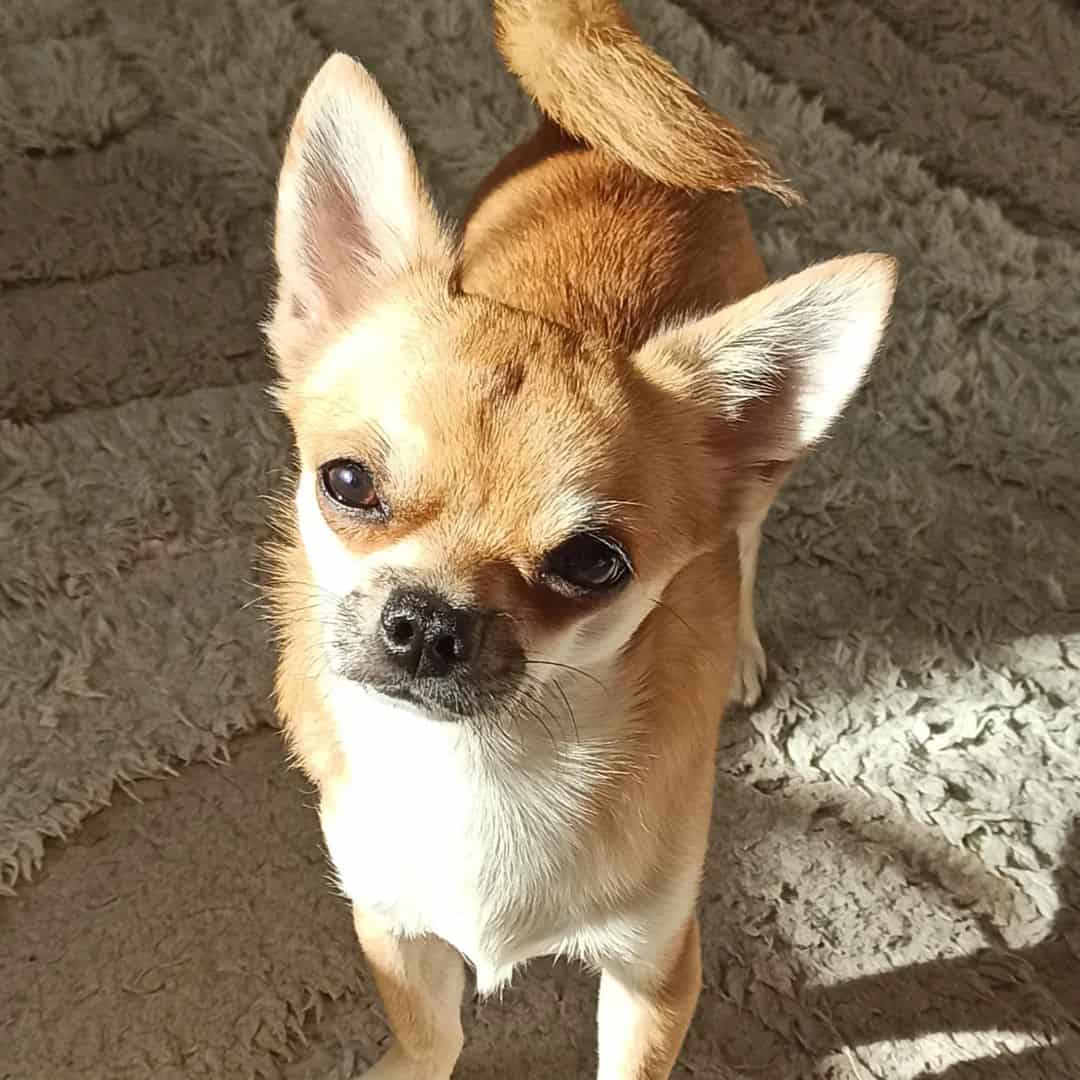
Photo from: @chihuahua_ray
Gold Chihuahuas can inherit smooth coats that are either long or short, ranging in color from intense to light golden brown/yellow.
Depending on the intensity of genes responsible for red pigment, gold Chis can inherit black, brown, or light brown noses and dark colored eyes.
Oh, and let’s not confuse a gold Chihuahua for a Golden Chihuahua which belongs to the Golden Retriever mixes
2. White
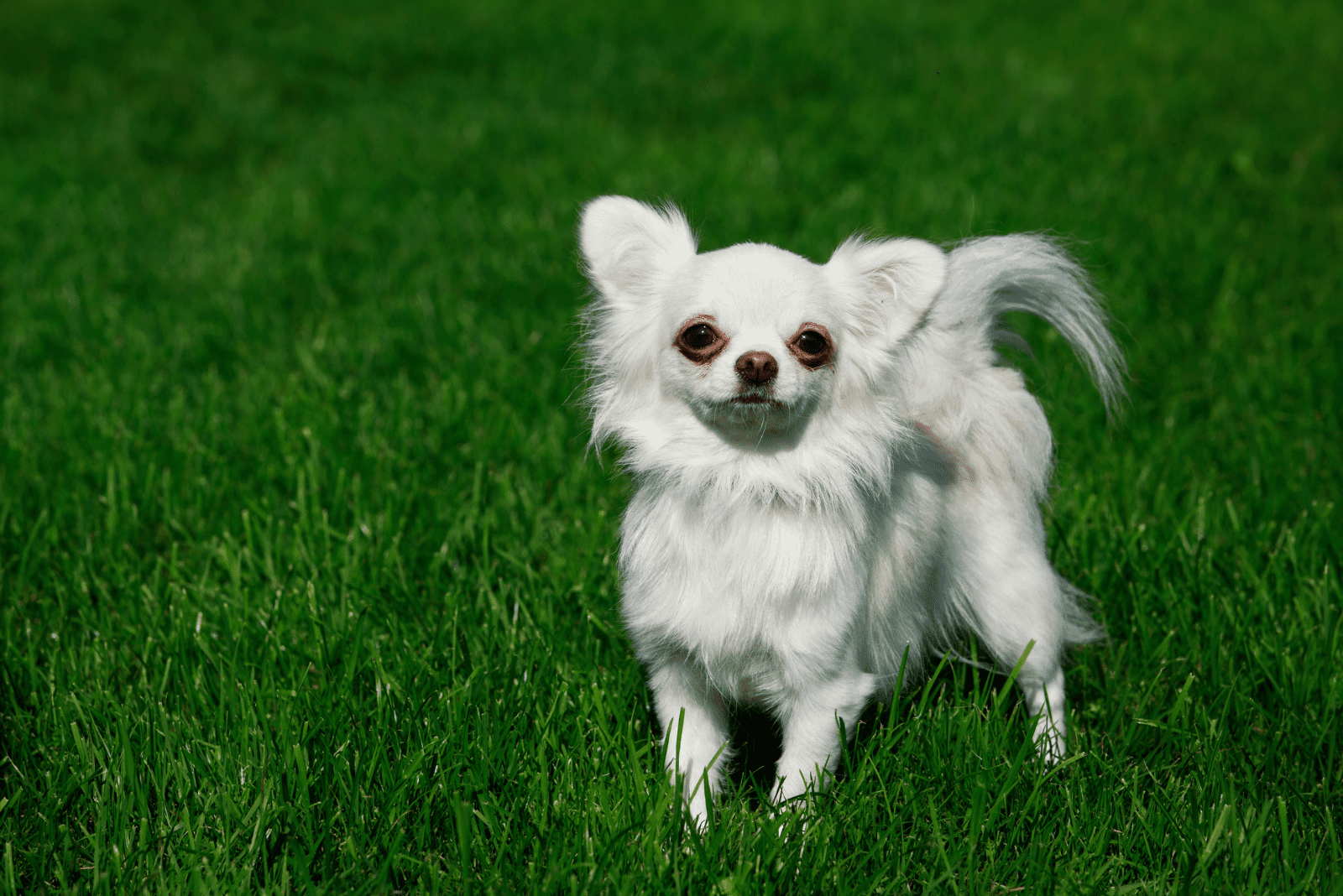
The rarest of them all, an angel-like tiny dog, the light at the end of the tunnel — the white Chihuahua!
White Chihuahuas are, well, pure white. Simple as that. They do not have any markings nor patterns and they usually inherit black noses and dark brown eyes.
At first sight, a pure white Chihuahua looks light beige, but once you take a second look you’ll realize that it is white as snow. A purebred pure white Chihuahua should have the same colored coat as that in white dog breeds.
Another thing to keep in mind is not to confuse a white Chihuahua with an albino Chihuahua. Albino dogs are not your average healthy white dogs as they suffer from this congenital condition.
If a Chihuahua happens to be albino, it will have pink eye rims, pink nose, and blue or even red eyes!
3. Sable
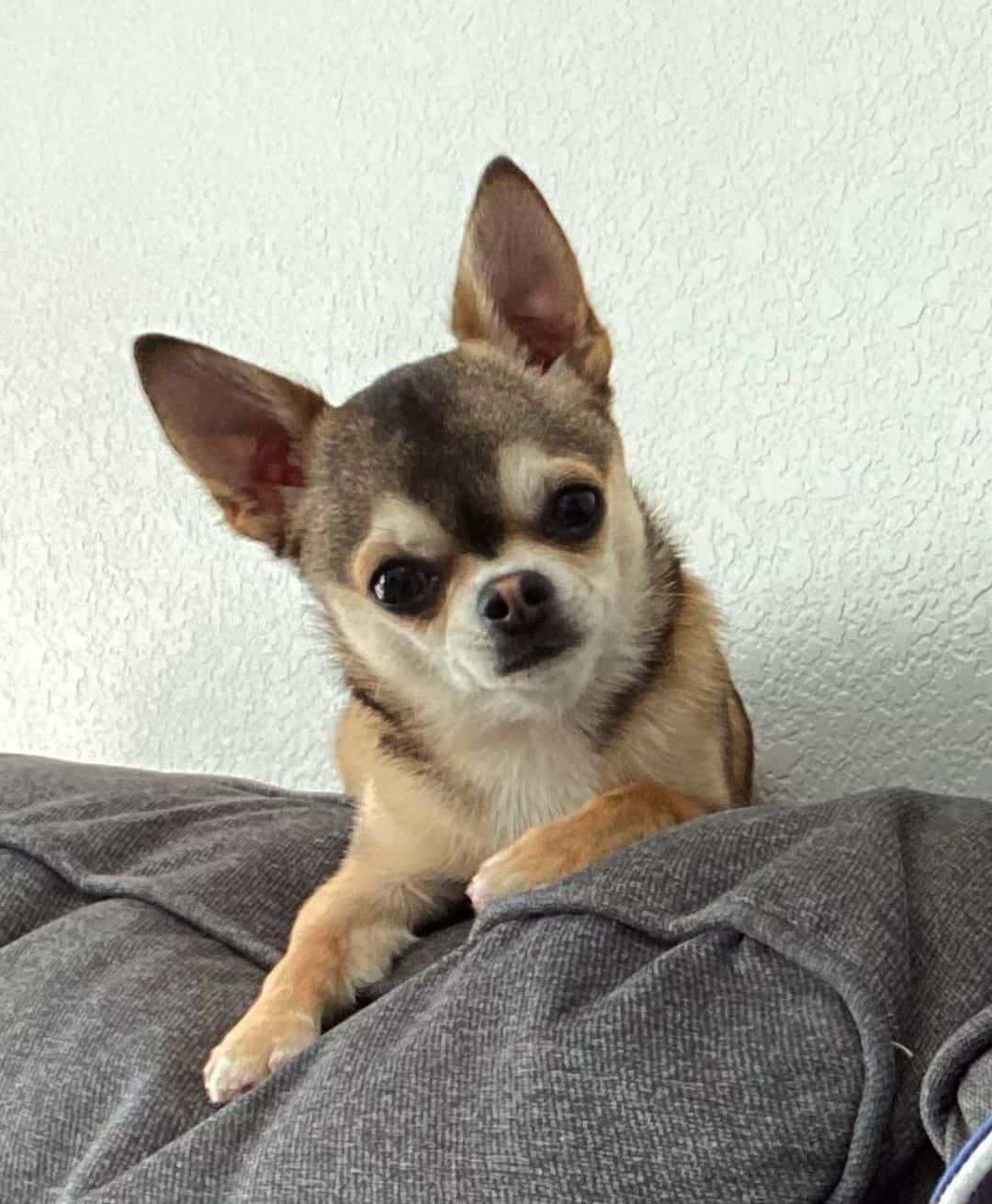
Photo from: @rogerfedthechi
The reason why sable color is very common in Chihuahuas is because of the dominant color gene. Sable Chis have fawn, silver, or chocolate colored hairs with black tips.
That is why there are three versions of sable Chihuahua coats:
• Chocolate Sabled Fawn
• Black Sabled Fawn
• Black Sabled Silver
These color combinations can be splashed around different areas of Chi’s body. Having said that, sable color in Chis can be:
• Clear — whole coat colored in brown/black tipped hairs
• Tipped — brown/black tipped hairs across the back, tail, head, and muzzle
• Shaded —brown/black tipped hairs across the neck and back
Although sable is represented in the purebred Chihuahua, different Chi mixes, like the Chi Husky mix can also inherit sable coat color.
4. Silver
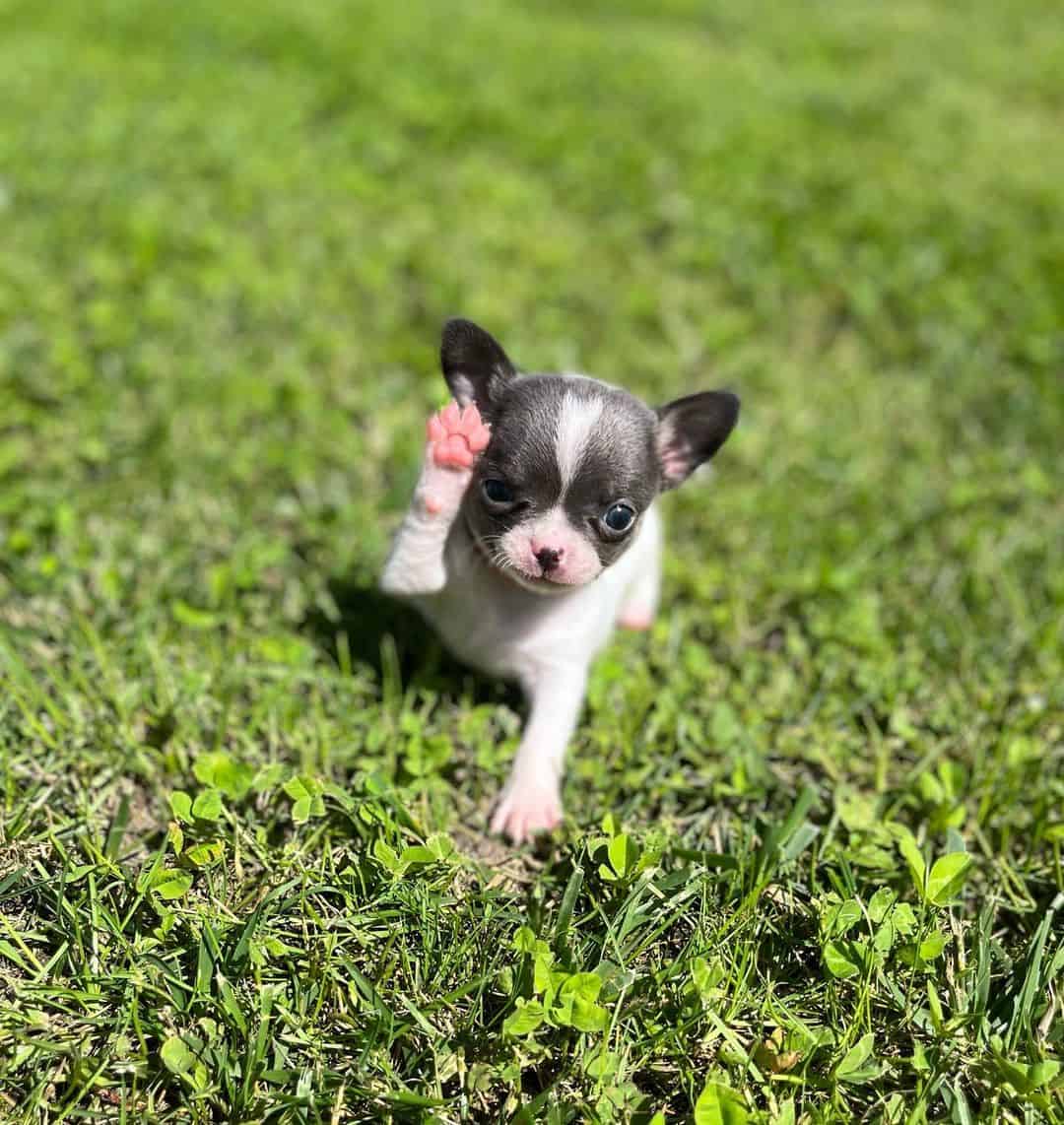
Photo from: @chihuahua_dominohouse
Most silver Chis inherit tanned markings above their eyes and white markings across their chest.
5. Blue
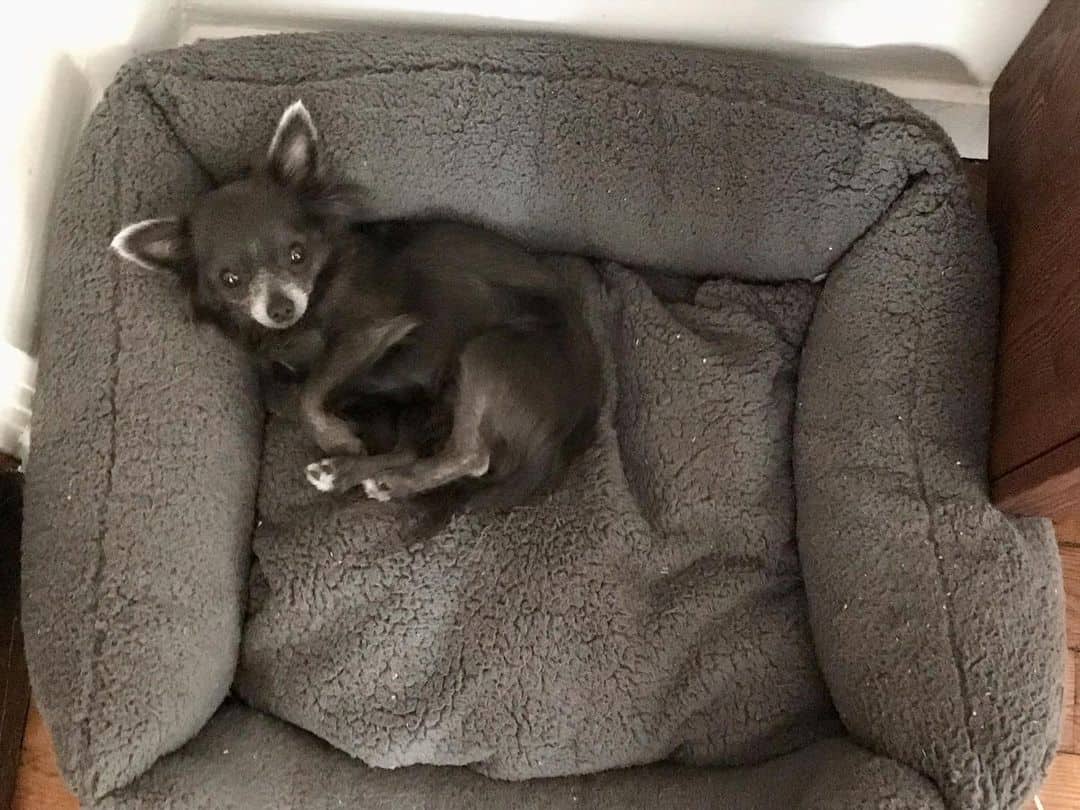
Photo from: @the_tick_ofthedog
A blue Chihuahua is very rare, but its appearance will make you fall in love with it! The blue base color of the coat can range from charcoal gray to lighter gray — it all depends on that dilution gene we mentioned earlier.
• Blue & White
• Blue Fawn
Depending on how much the color has been diluted, the blue portion of the Chihuahua’s coat may be dark or lighter in hue.
Blue Chihuahua’s color is often compared to the Weimaraner coat colors.
6. Brindle
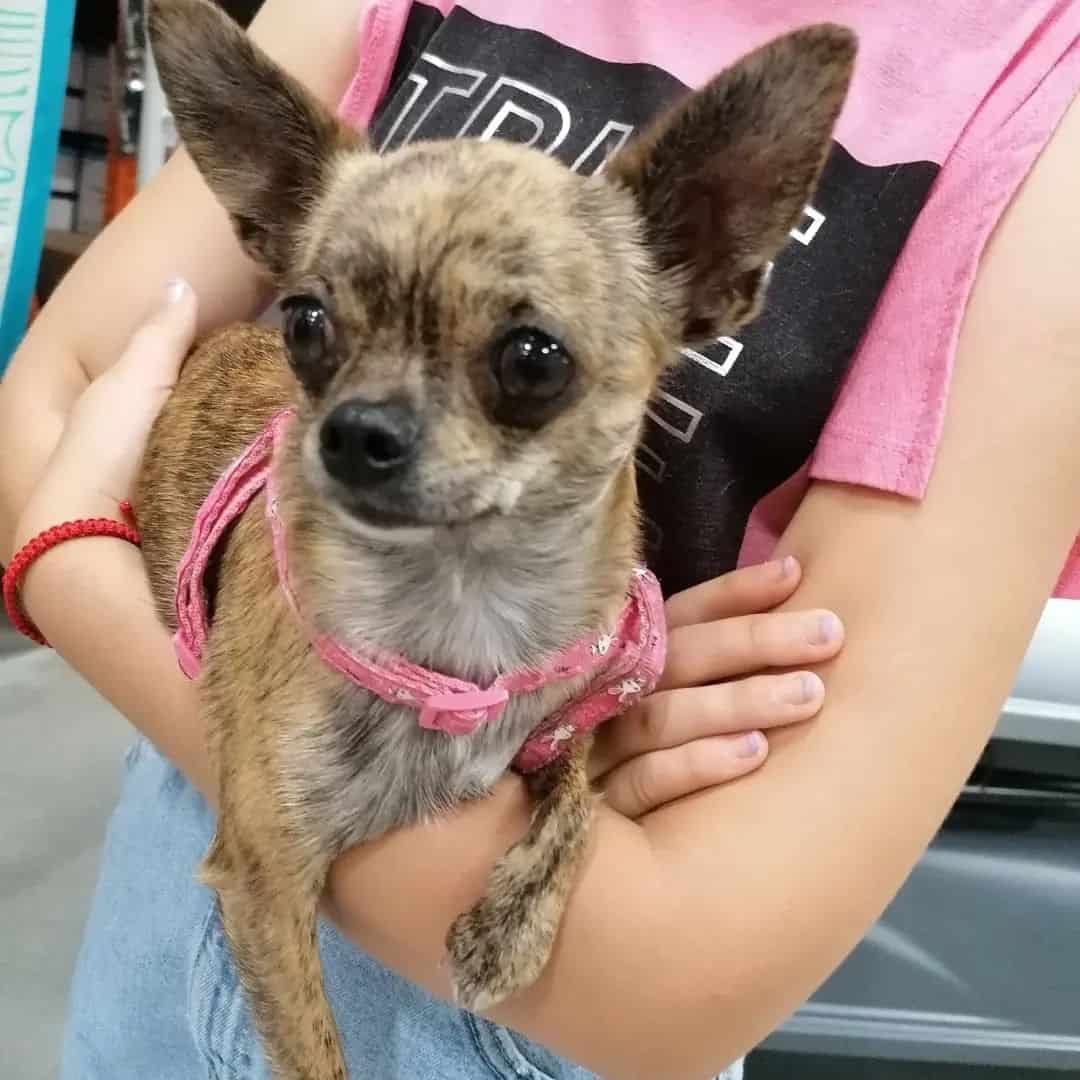
Photo from: @tyris28918
Colors of the Boxer dog breed usually have black brindling in them! In several dog breeds, including the Chihuahua dog breed, purebred show dogs are encouraged to display the brindle pattern.
Depending on how certain color genes combine, brindle Chihuahuas can inherit different colored coats such as:
• Fawn brindled black
• Blue brindled fawn
• Chocolate brindled fawn
Brindle Chihuahuas usually have black or liver colored nose and paw pads. Most dog lovers want a tiger striped dog of small size like the brindle Chi!
7. Black & Red
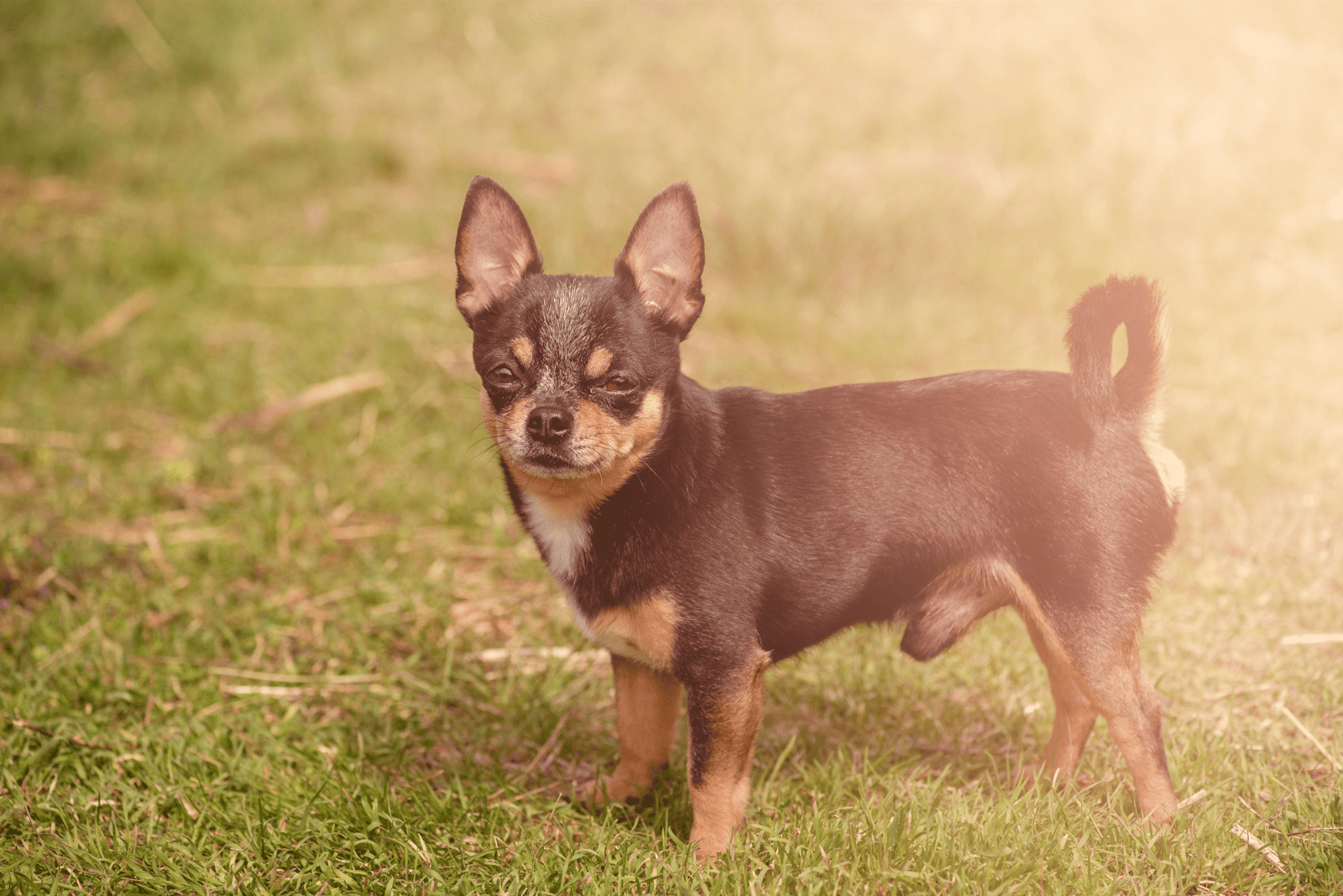
The black & red Chihuahua color is similar to the black and tan one. The red markings are distributed the same as in black and tan Chis, but they are darker in color.
Red markings are similar to chestnut red, liver or mahogany color.
8. Black & White
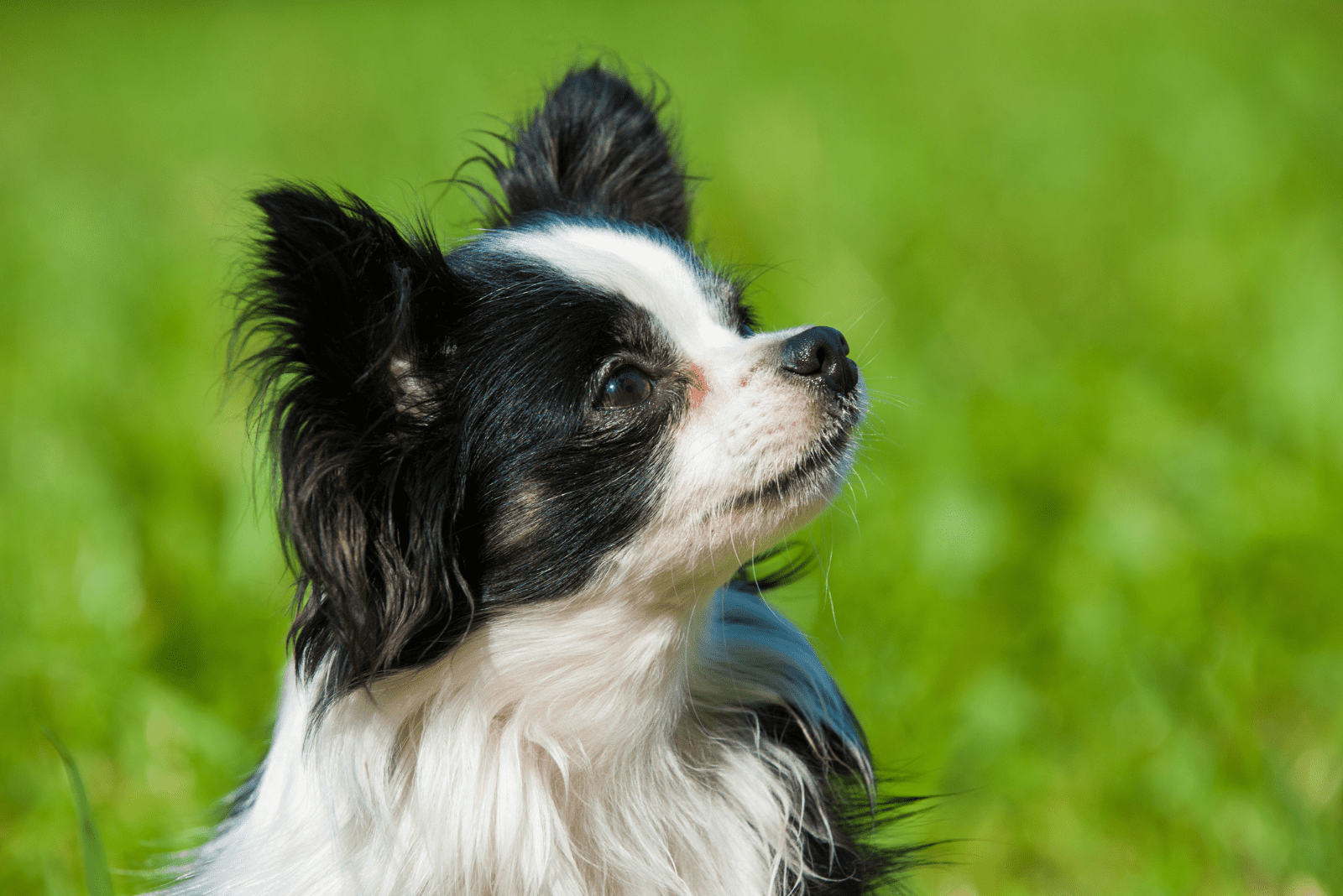
In this case, white coat is mostly located across the Chihuahua’s chest, legs, and paws.
The white may appear as silver, due to the lack of pigmentation. In other words, the white marking is not as intense as that we see in Border Collie colors.
9. Chocolate & White

Photo from: @ajo_chihuahuas
A chocolate & white Chihuahua is a chocolate colored Chi with some splashes of white.
Its base is a darker chocolate color that gives remarkable shine to the Chihuahua’s smooth coat. White markings come like a cherry on top!
10. Chocolate Blue
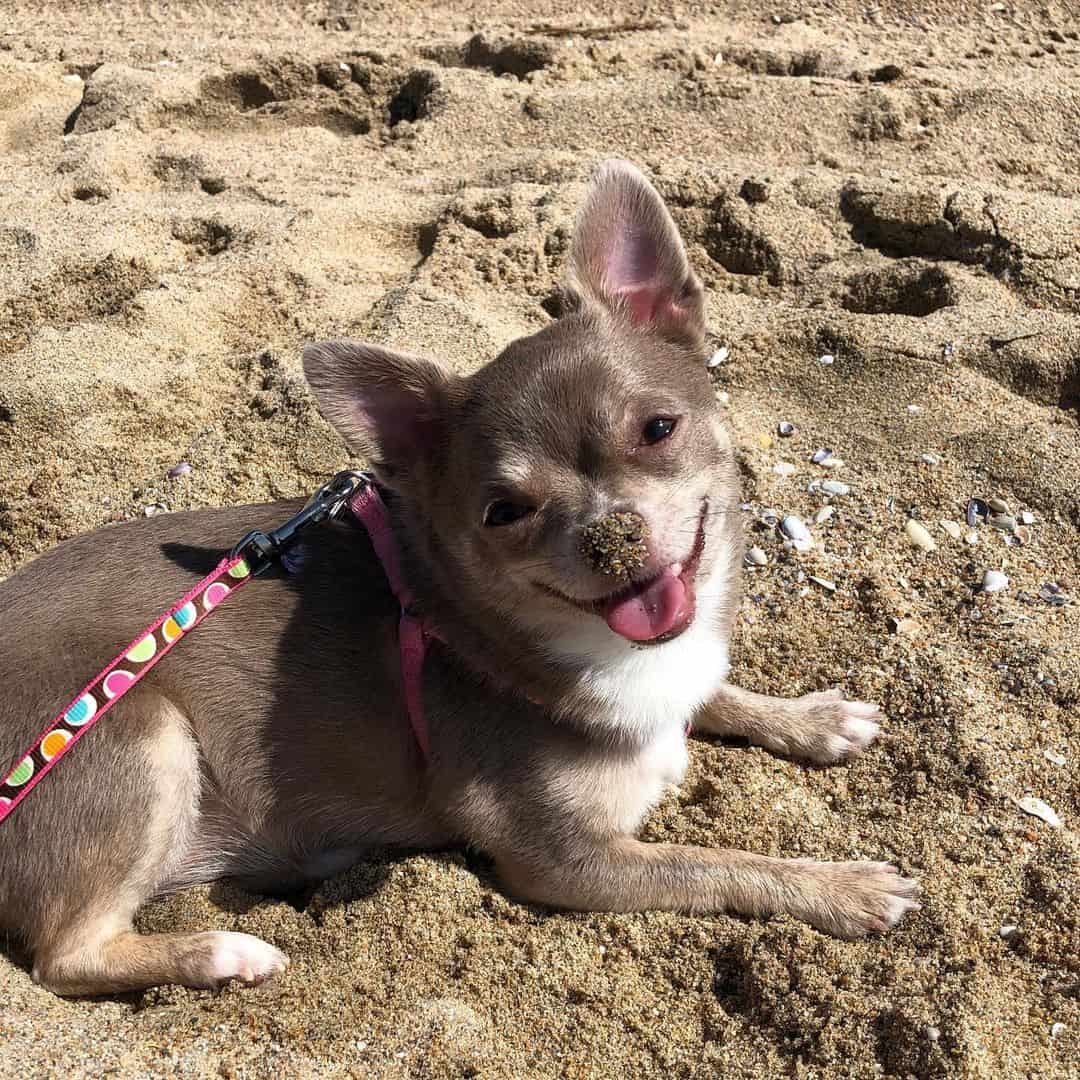
Photo from: @shellsnatureshop
Chocolate blue isn’t a very favored Chihuahua color, because it is regulated by a dilution gene that is linked to congenital health issues (deafness and blindness).
However, the chocolate blue Chihuahua is a gorgeous pup with a very soft coat!
11. Cream & White
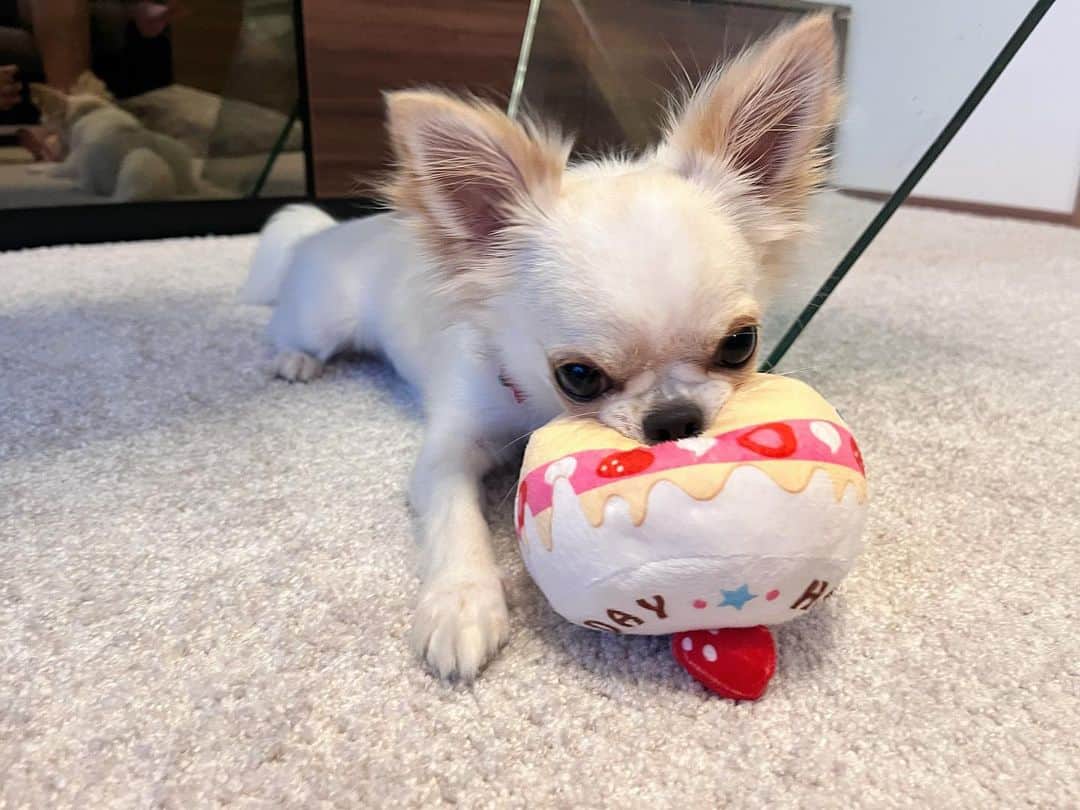
Photo from: @pu_rinlife
The cream color is usually very light and white markings really add to the coat color contrast.
12. Gold & White
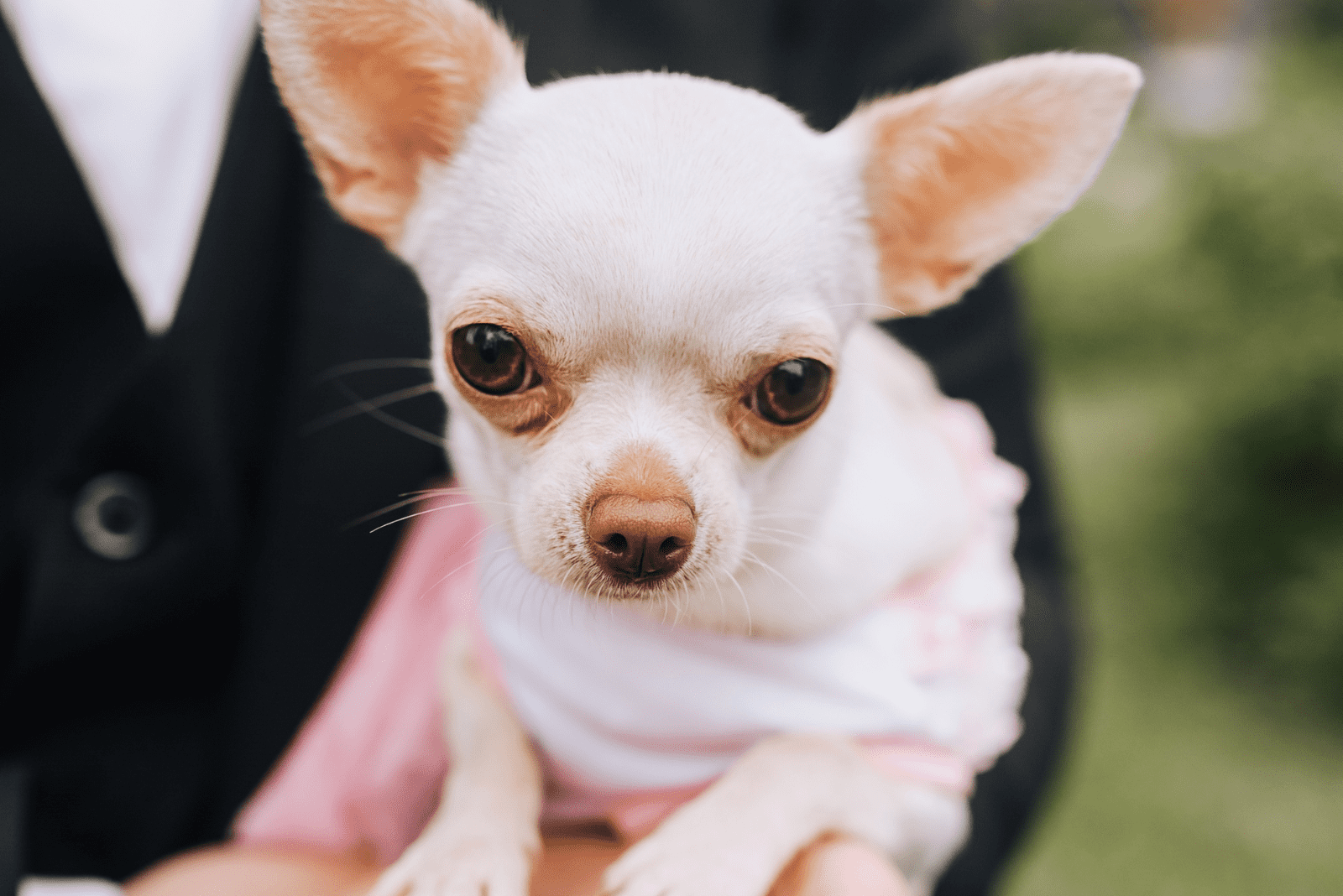
Gold & white Chihuahuas have gold base color and big white markings across legs and muzzle. Perhaps the largest white marking is located across the Chi’s chest.
Another cool feature in gold & white Chihuahuas is that they inherit a white tipped tail.
13. Red & White
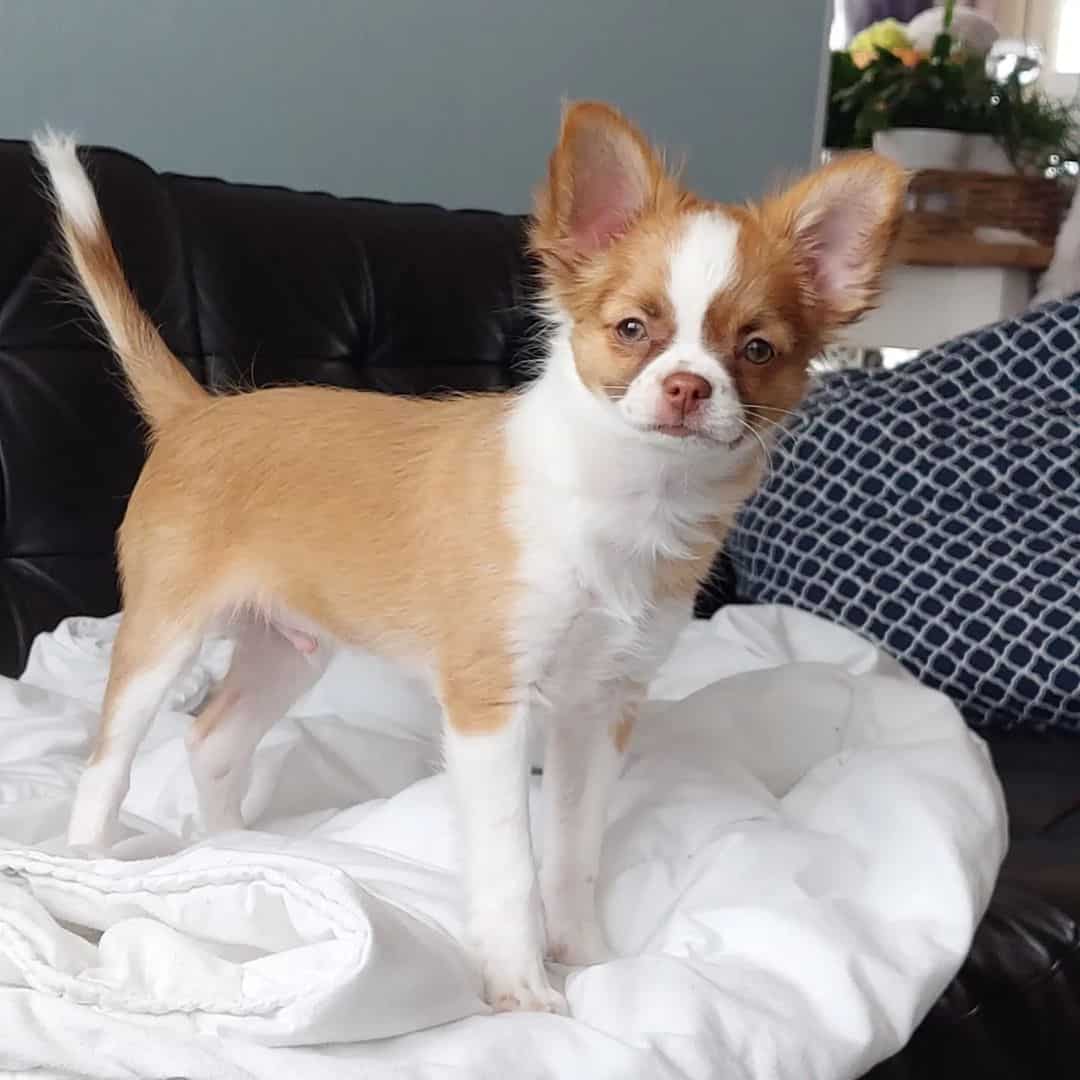
Photo from: @_chihuahuahugo_
Chis with both short and long coats can inherit this color combination.
14. Silver & White
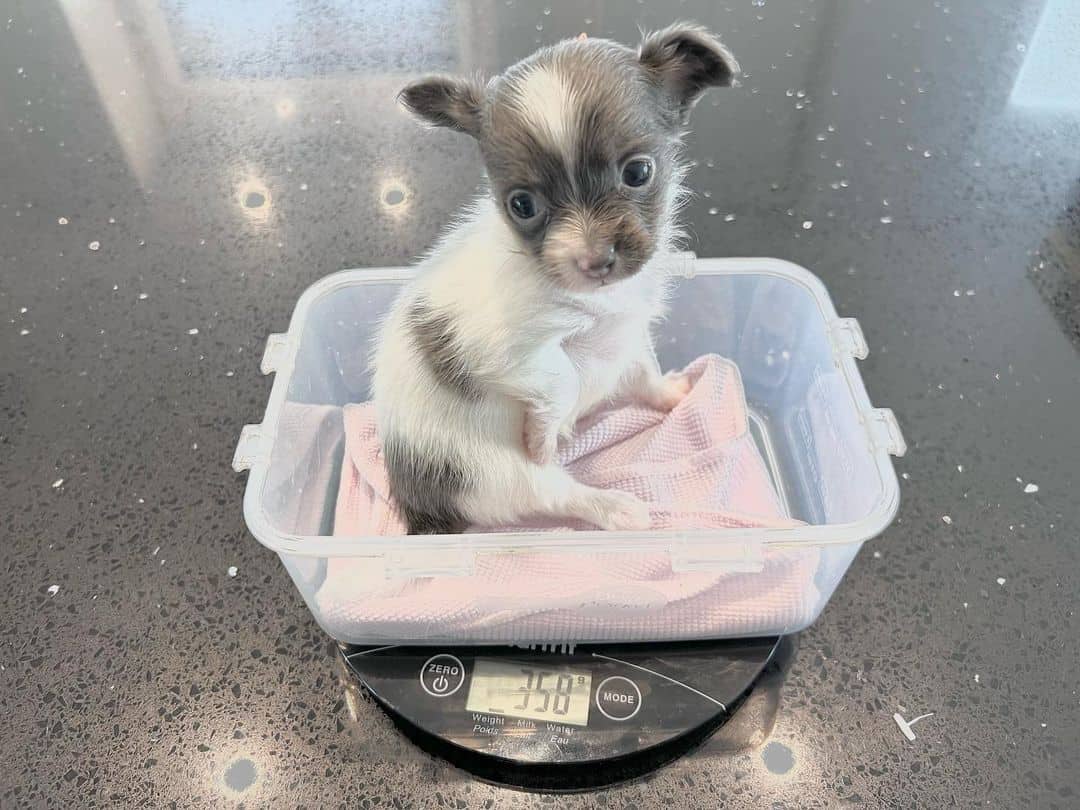
Photo from: @elevage.natamour
Lastly, silver & white is a color combination of base coated silver Chihuahuas and large white markings that appear as patches across the body.
Silver & white Chihuahua coat color and white marking distribution resembles that of a teacup Husky!
Chihuahua Markings And Patterns
The Chihuahua breed wouldn’t be the same without its signature coat markings and patterns. Most single-colored Chihuahuas hold a surprise among the uniform coat colors — a white marking!
Do all Chihuahuas inherit only white markings or is there more to their coat colors than just plain white?
Of course there is!
Not only do Chis inherit big chunks of color patches, but they also inherit the so-called “splashed colors”.
1. Black Brindling
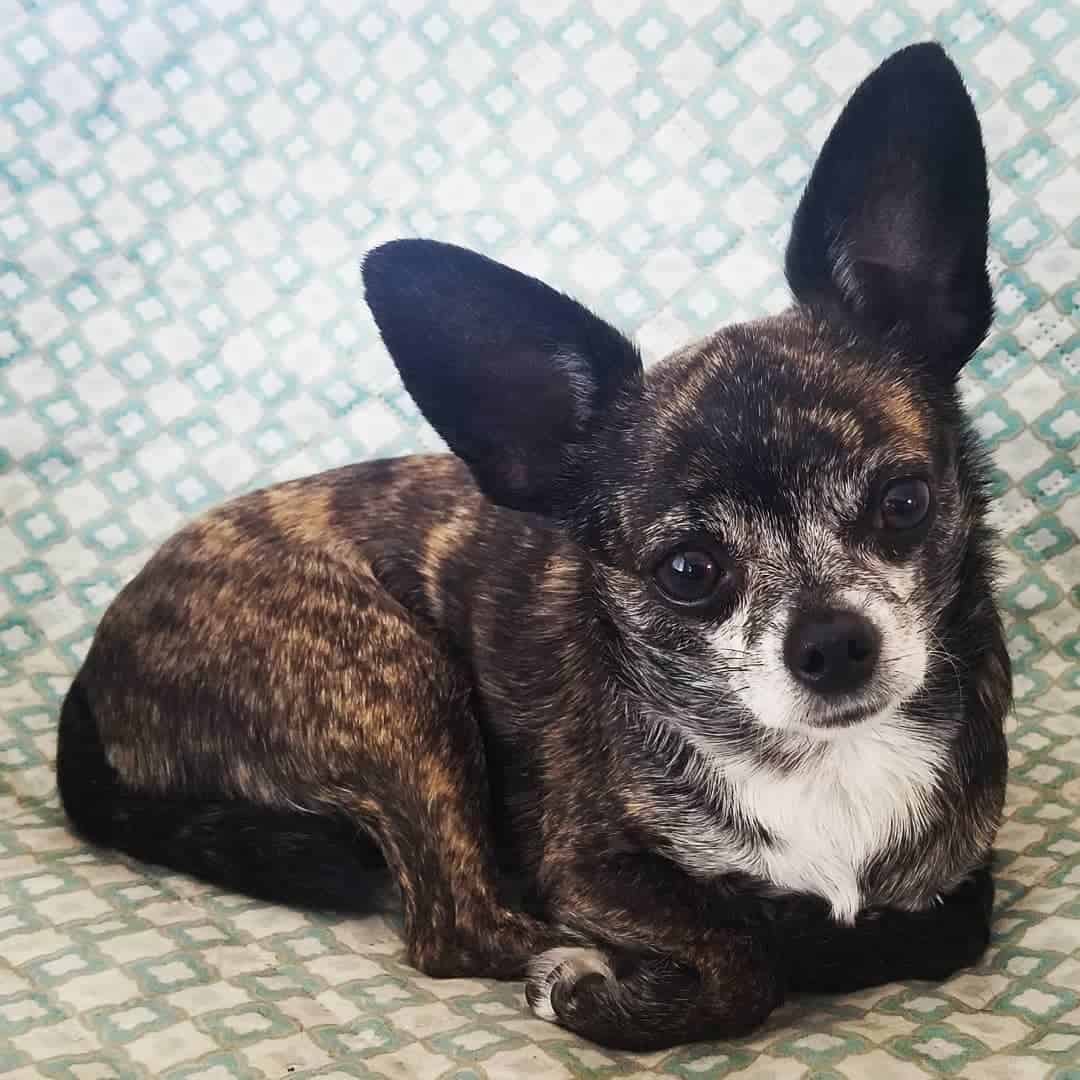
Photo from: @lunaroseavila
Reverse brindle Chihuahua dogs have the appearance of light stripes on a black base coat color. Think of it as tiger stripes on a small dog!
2. Black Mask
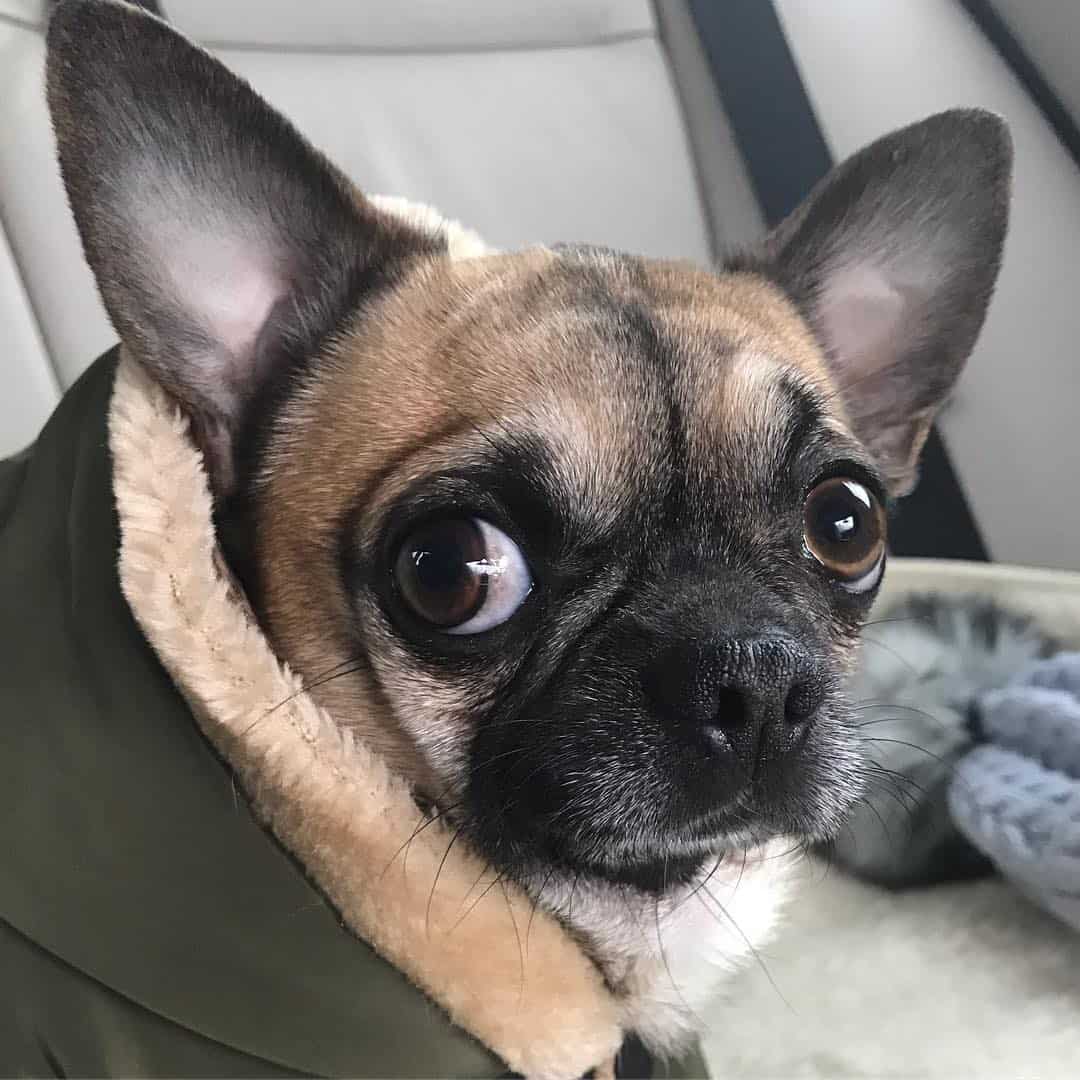
Photo from: @jackie_the_chihuahua
A black mask is also called a “melanistic mask”. It is a dog coat pattern that resembles a mask on the Chi’s face. It is also known as black masking.
Canines that inherit the distinctive black mask pattern are either red, yellow, tan, fawn, or brindle dogs.
Instead of red pigment, the hairs located on the muzzle (or the entire face) are caused by the black pigmentation gene, hence the “black mask”.
The black mask is inherited as a dominant characteristic in several dog breeds colors like German Shepherd, Great Dane, Akita Inu, Pug, and Bullmastiff.
3. Black Sabling
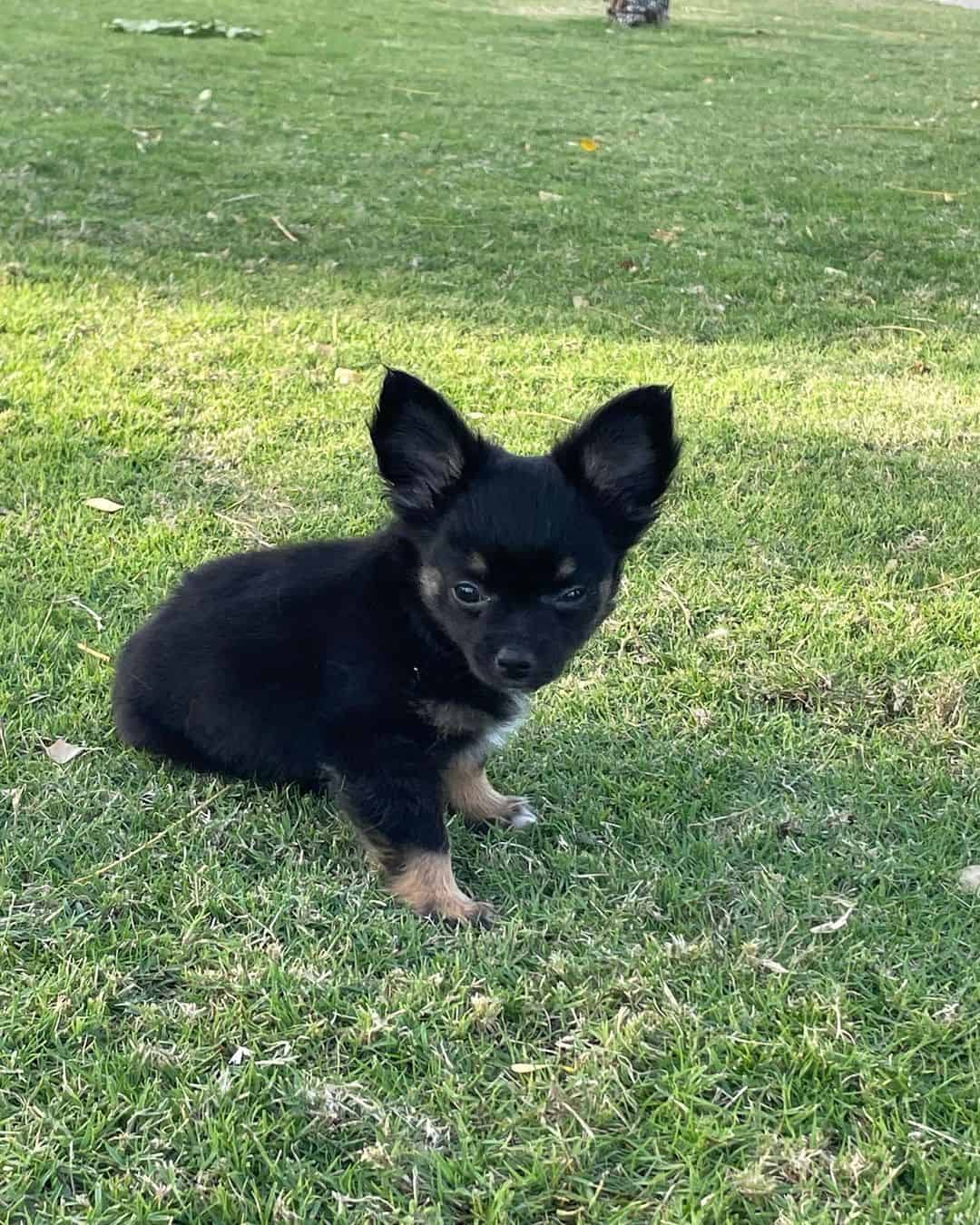
Photo from: @el_chapo_and_cartel
Black dogs are considered sable if they have lighter colored roots of their hair. Black sabling is a coat marking that appears to be a hue of brown and is pretty close to black.
Black sable hue is typically seen as a neutral color due to its brown undertones. With time, the black normally becomes lighter and fades.
The black sabling, though, can continue to be pretty thick and not fade off as much. Black sabling typically a marking that is mixed with the fawn base color of an overcoat.
4. Merle Markings
The only way a Chihuahua with merle markings (merle Chihuahua) can exist is if it carries genes from another dog breed. This is because purebred Chihuahuas never had nor produced any merle puppies — it’s not in their genes.
Although merle markings are permitted under the American Kennel Club registration rules, the United Kennel Club disqualifies merle Chis. Even the Chihuahua Club of America is not fond of merle Chihuahuas.
Merle Chi not being a purebred dog is one reason, here’s the other.
Due to the fact that the merle marking gene lightens and whitens the pigmentation of the merle Chihuahua—causing the pigment in the ears and eyes to also lighten—is another issue with this marking.
Merle Chi markings are connected to a number of health problems such as:
• Skin cancer
• Hearing impairment (deafness)
• Vision impairment (blindness)
• Iris Coloboma
• Canine Microphthalmia
• Canine Microcoria
• Merle ocular dysgenesis
These health issues mostly occur later in life of merle dogs. And, not all merle Chihuahuas inherit these health problems. There is a high chance that they will develop if a merle Chihuahua puppy has two merle parents.
5. Spotted On White
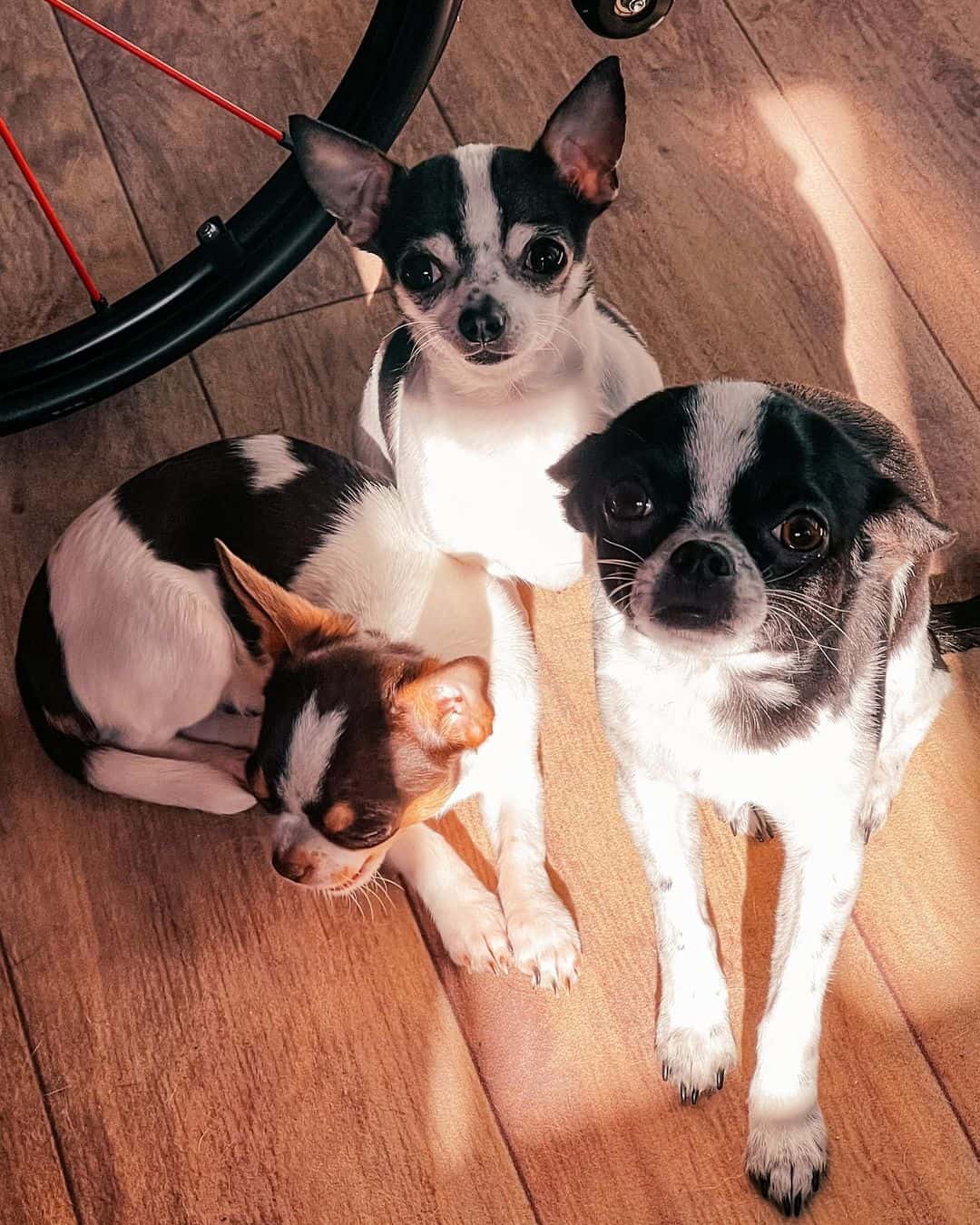
Photo from: @dukeanddaizy
Piebald spotting is another name for the white spotting pattern that appears on white with black spots.
There are numerous spotting hues that can be liver, red, dark brown, chocolate or black and white spotted. We refer to a Chihuahua dog as being tricolored if it has distinct colored spots on its white base coat.
Congenital health problems can affect Piebald Chihuahuas just like they can their Merle counterparts.
These types of genes that are carrying the coloring are linked to ear and eye issues, including blindness and deafness. Because of this, certain breed registries have banned these hues.
6. White Markings
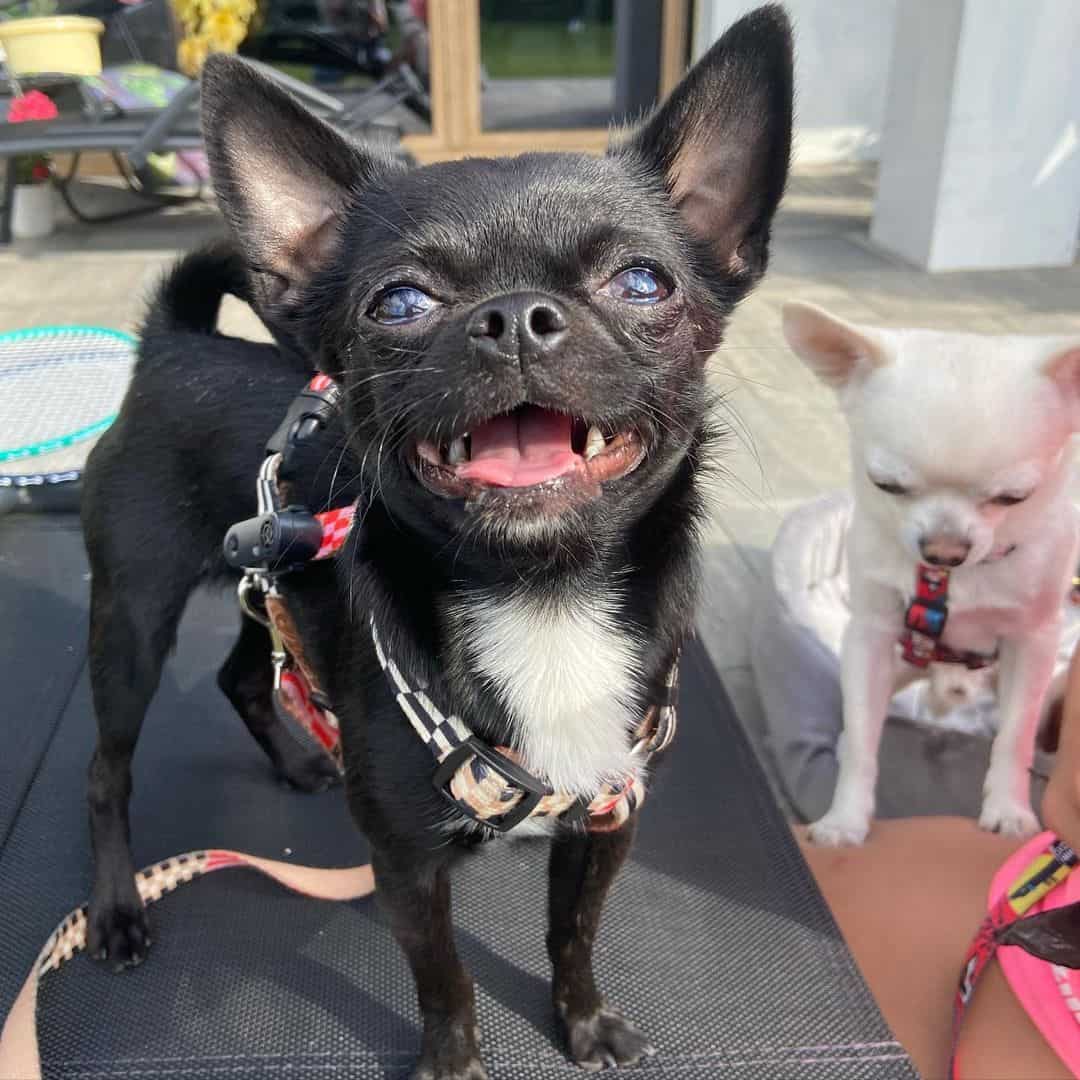
Photo from: @coco_teo_chihuahua
There can be a different amount of white markings on a Chihuahua’s body. It can range from zero to a completely covered body. In the case when white covers the whole Chi’s body, we are then referring to a white Chihuahua.
Surprisingly, what causes the color gene responsible for the development of white markings is a piebald gene, which is recessive.
So, a Chihuahua dog with one white gene will have half or one third of its body colored in white markings, whereas a Chi with two white genes is mostly or entirely white.
Chihuahua muzzles, like black masks, can be decorated with white markings.
7. Black Mask With White Markings

Photo from: @balounamy
A Chihuahua puppy inherits is black mask that colors its muzzle and the area around the eyes. White is usually located across the chest.
The base of their coat could be in a different color. The majority of Chihuahua dogs with these markings have a fawn base.
Black masked Chis with white markings among the rarest pups in the breed.
8. Blue Mask
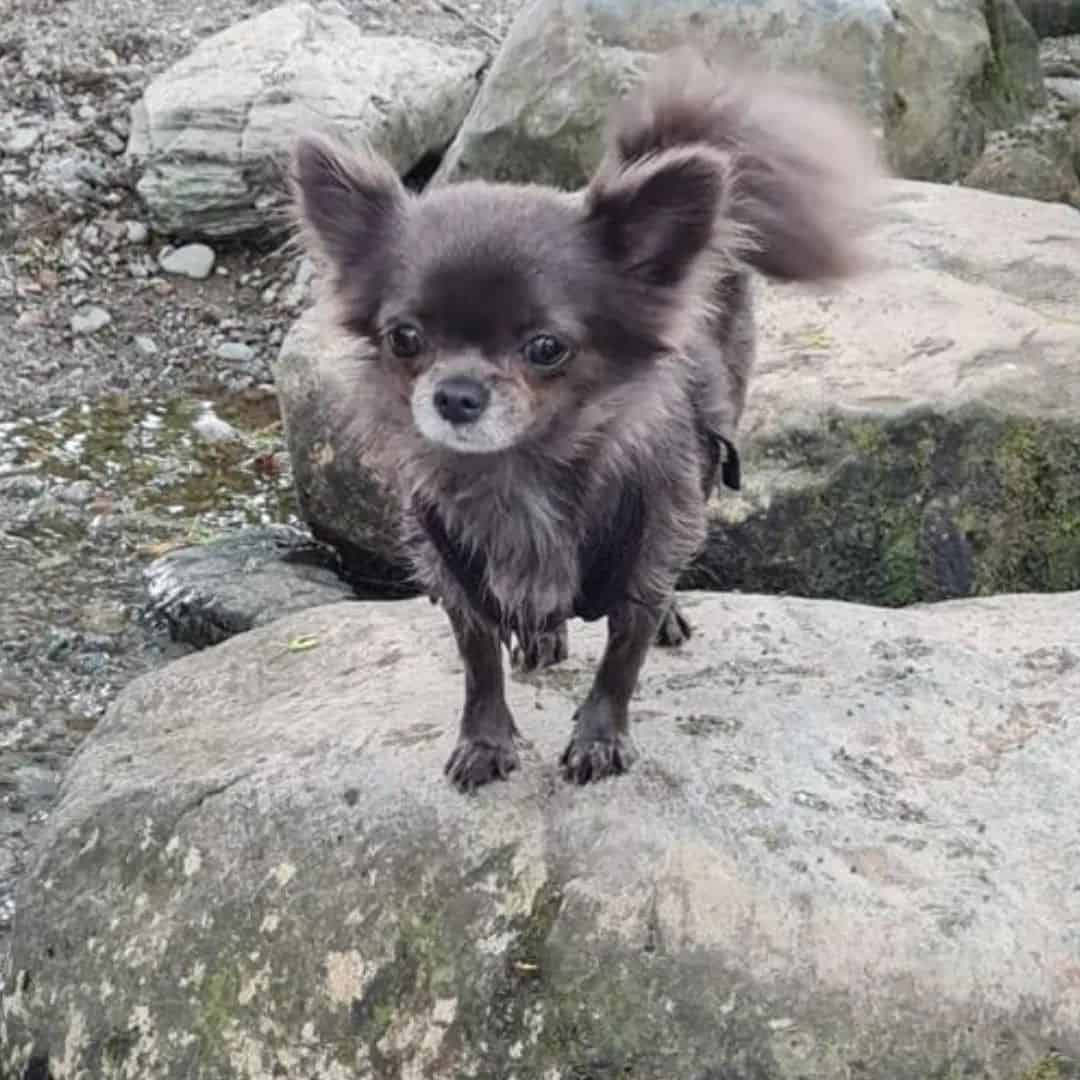
Photo from:@valentinhuachihuahuas
As a result, a mask will match the Chihuahua dog’s predominant color and may be liver, blue, or isabella. It may also display the merle pattern.
A blue mask in Chihuahuas usually appears on the sides of the muzzle and above the eyebrows. But, a Chihuahua dog wearing a blue mask may have the base coat color covering all or some of these areas.
A “dudley” or pink nose may develop in some Chihuahua dogs, while in others the entire pigment fades to a gray or blue color.
Masks can cover everything from the entire muzzle to only the tip, as well as the eyebrows and ears.
However, there is one exception: Sometimes, graying doesn’t affect masks (as seen in Poodle colors). There is currently no known explanation for this odd anomaly.
9. Cream Markings
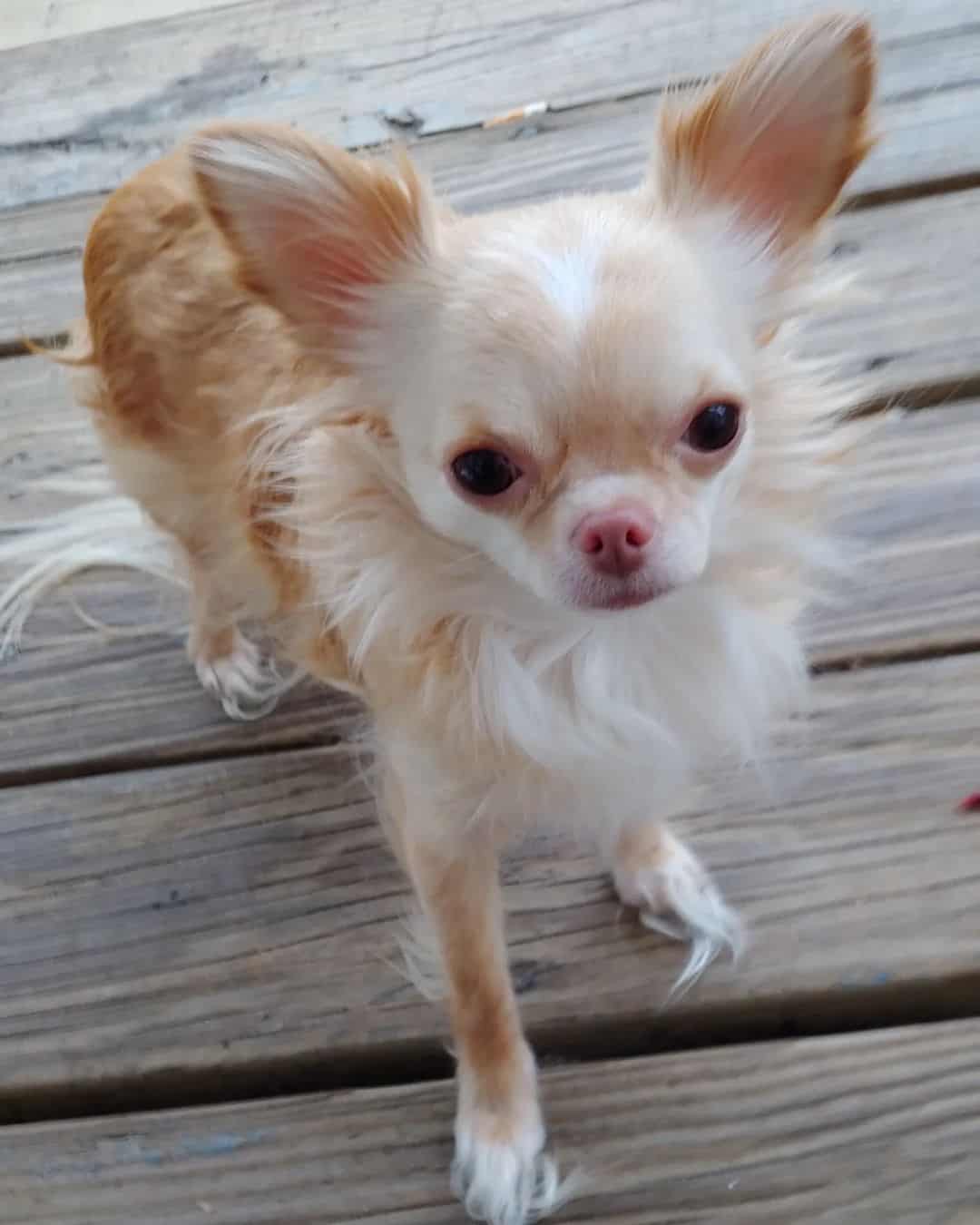
Photo from: @larissalurid
Cream markings are located on Chi’s muzzle, torso, and sometimes they can be found across the limbs. Note that these markings don’t appear as spots, but as patches of solid color.
Cream markings on Chihuahua dogs may look like a pale brown or beige shade, but an interesting fact is that all cream markings derive from red pigment.
Although you may not see the red pigment protruding from cream markings, they are regulated by genes that carry red coat coloring.
10. Fawn Markings
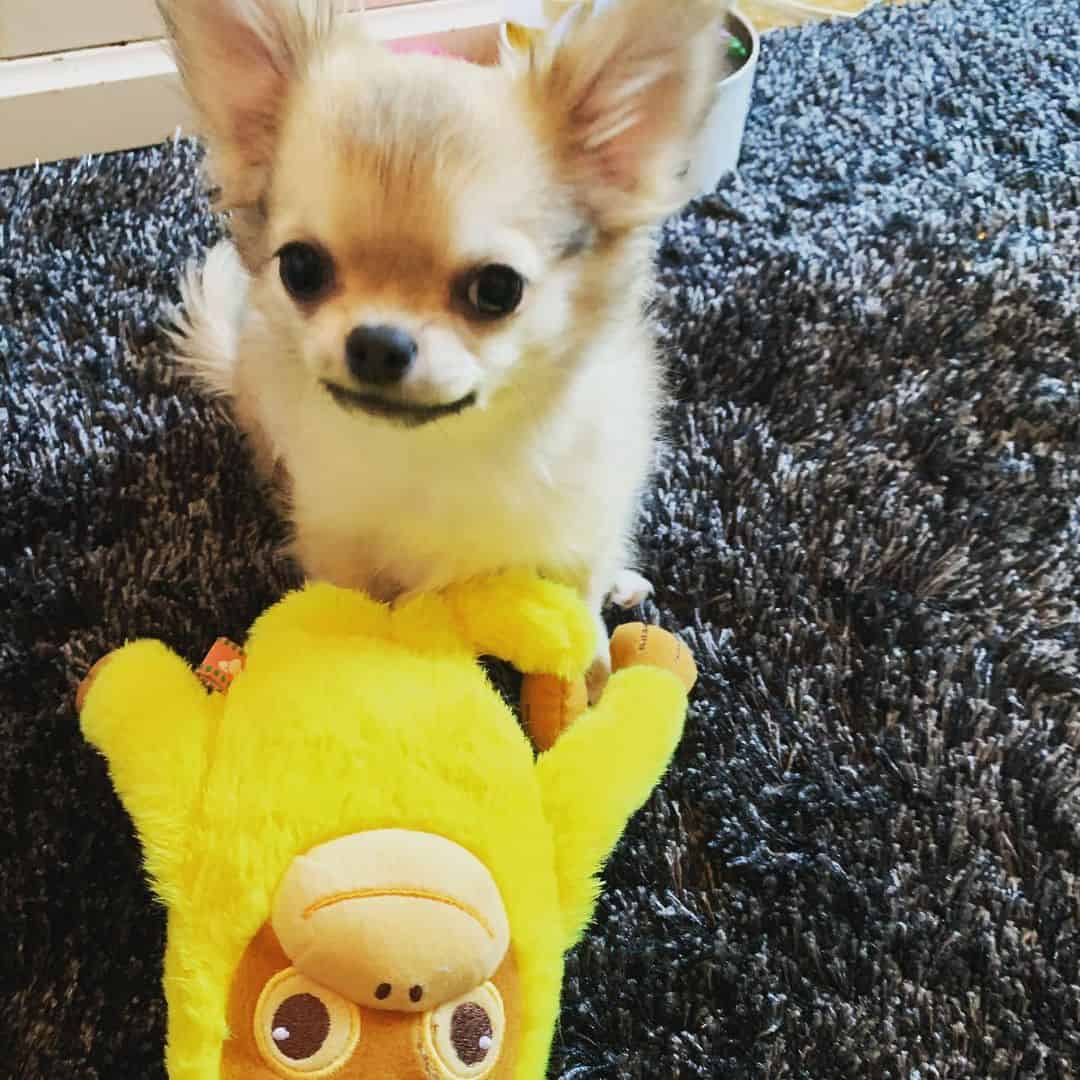
Photo from: @noah.mona_chihuahua
But, as we previously seen, Chis can be blue or black and inherit fawn markings across their body.
The hue of fawn markings can range from light tan to light fawn, depending on what kind of colors the Chi’s parents have.
11. Red Markings
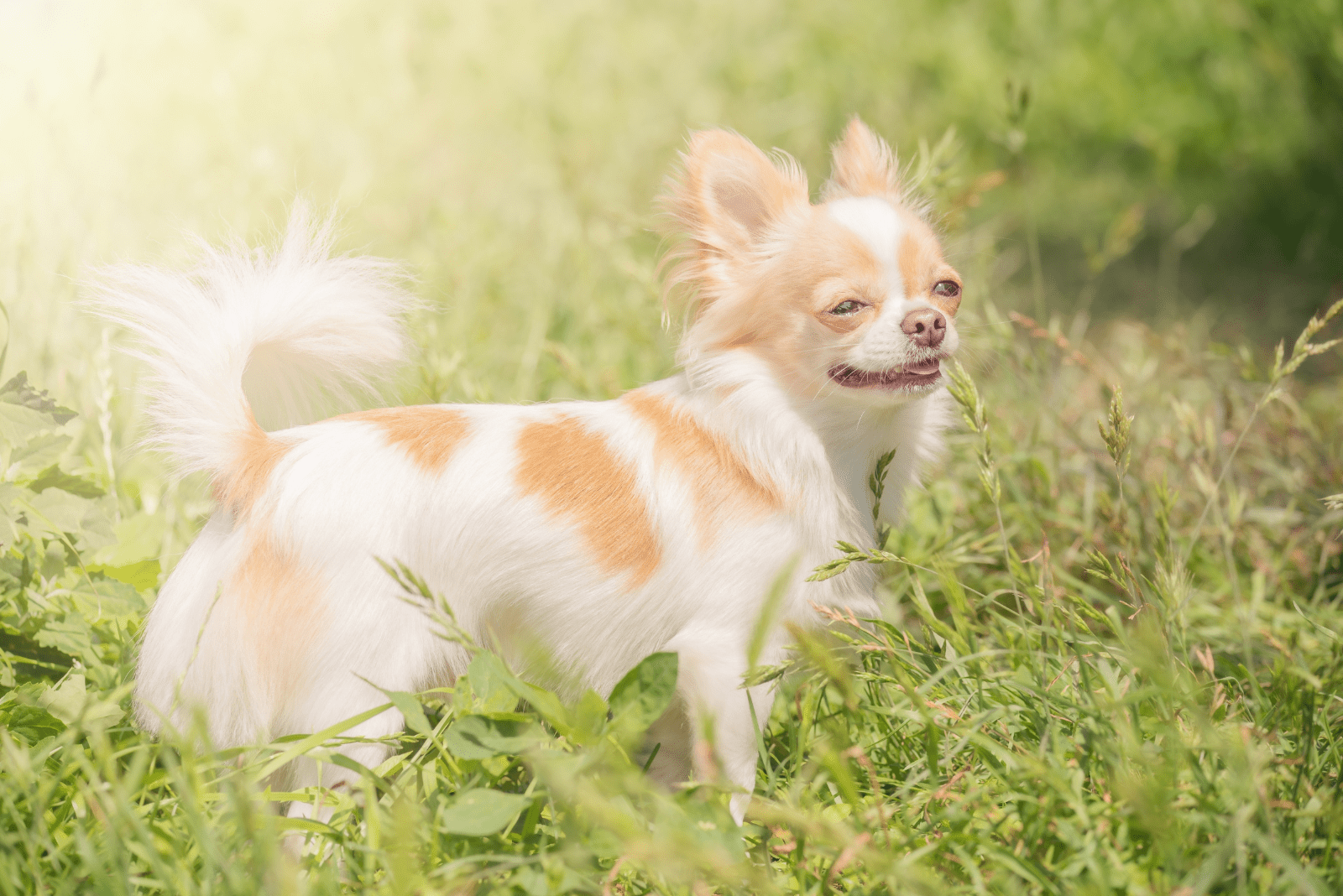
Chihuahuas with red markings look amazing! Most of them have white base coats with diluted red colored spotting.
A fun fact about this coat pattern is that most Chis that inherit red markings are long-haired Chihuahuas.
The red can move towards a deep red or an intense orange which gives the Chi a remarkable appearance. Red markings look like patches of abundant colors that are spread across the Chihuahua’s body.
Normally, red markings appear on the Chi’s face, around its eyes and on their ears. Chihuahuas with red markings often inherit a white blaze that spreads towards the forehead.
Red markings can be seen on both sides of the body, as well as across the abdomen.
12. Kiss Marks
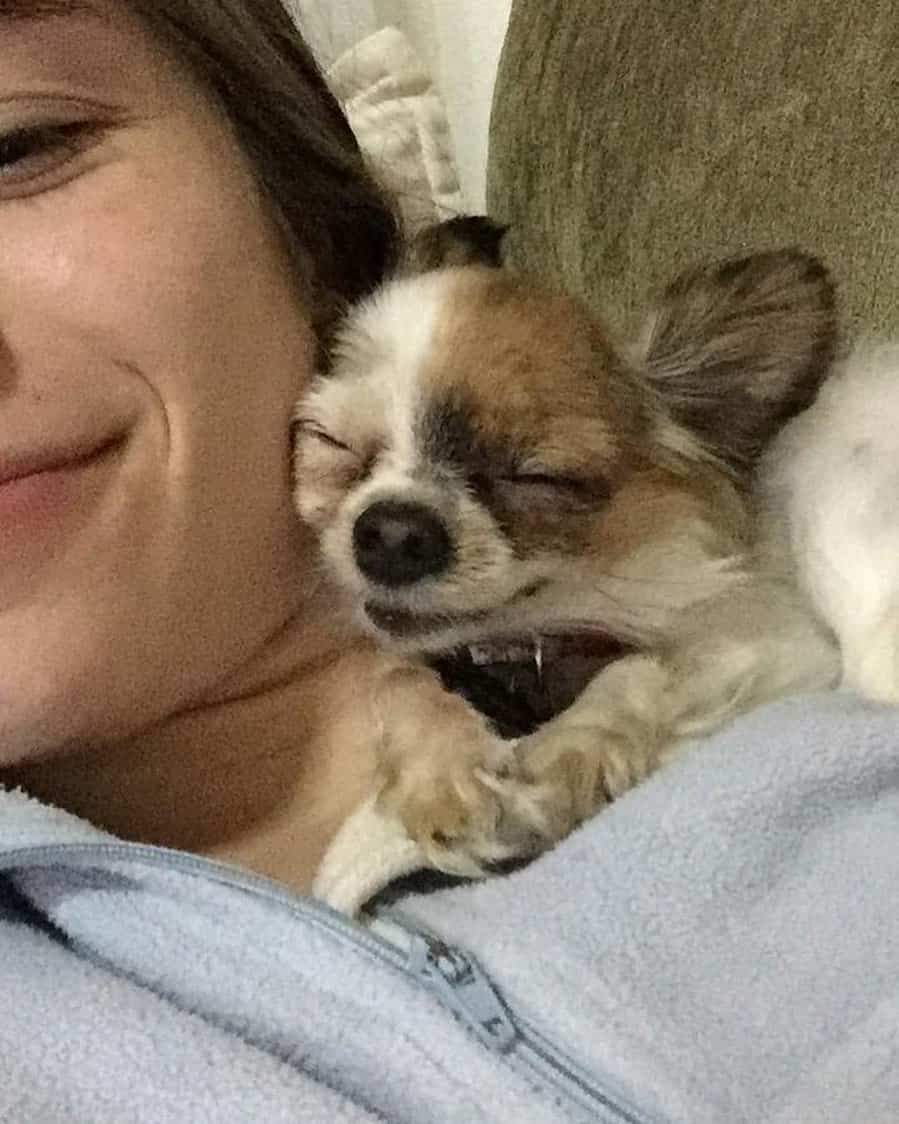
Photo from: @oifredin
Kiss marks refer to different colored markings that are located on the Chis face. They are often found above the eye area, on Chi’s eyebrows. Although rare, kiss marks can be located on the dog’s cheeks.
In the Chihuahua dog breed, kiss marks usually come in a vivid tan color, similar to what we see in Doberman Pinschers and Rottweilers.
Chihuahua Eye Colors
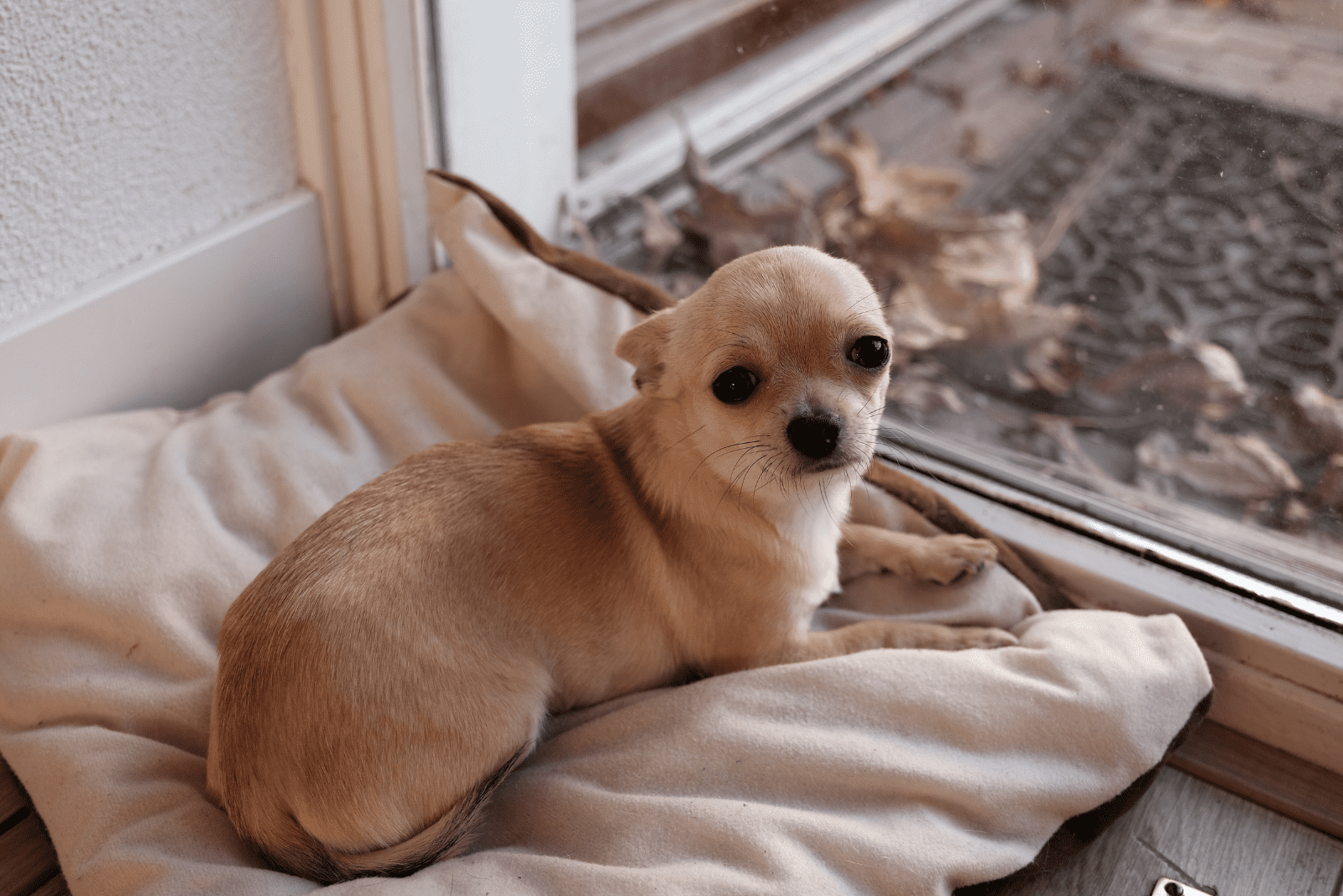
Chihuahua eye colors can vary from brown, gold, ruby, dark brown, re, gray, to blue.
Ruby eyes are typically found in light colored Chihuahuas. In contrast to that, hazel eyes can be found in light brown or white colored Chihuahuas.
In very rare cases, some white, blue or merle Chihuahua puppies inherit blue eyes. As striking as they are, blue eyes in dogs, especially in small dogs like Chihuahuas, are linked to certain congenital health problems.
This should not be confused with baby Chihuahuas because almost all puppies have blue eyes when they first open them. The color change happens in the period between 9 and 15 weeks when their eyes turn to a permanent color.
Chihuahua Coat Types
These little dogs from Mexico acquire lots of different coat lengths and types!
Did you know that the Chihuahua dog breed can inherit both coat types — single and double coats?
This is rarely seen in other dog breeds because most are either single-coated or double-coated.
Chihuahuas with a single coat have a top coat made up of dense guard hairs. Chihuahuas with a double coat have an outside layer of thicker hairs and an inner layer of softer, finer hair.
The short-haired Chihuahua has a shiny, silky coat that clings tightly to its body, whereas the long-haired Chi has most of its fluffy fur located on its tail, abdomen, thighs, and around its ears.
Like all dogs, Chihuahuas shed. But, they don’t shed as heavy as German Shepherds do. Purebred Chihuahuas normally shed throughout the year. Spring and fall is when they’re going to shed the most.
Overall, Chi’s coats are pretty low maintenance.
The Glorious 7 Types Of Chihuahua Dogs
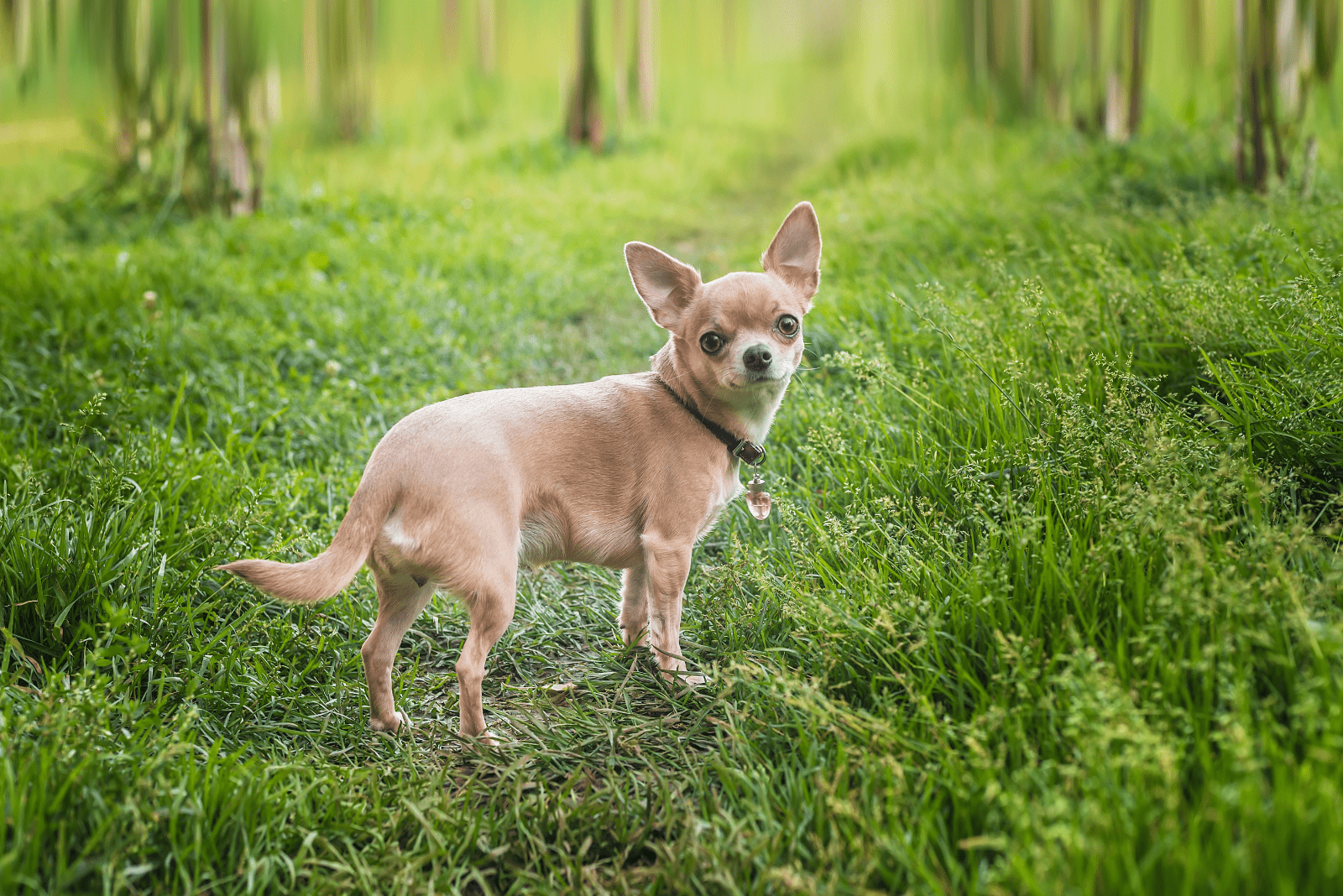
Most paw lovers are not aware that the Chihuahua dog breed is very versatile. It seems that all Chihuahua dogs look different. Some inherit different coat colors and types, while some Chis inherit completely different head shapes.
So, without further ado, let me introduce you to the 7 types of Chihuahuas:
1. Short Hair Chihuahua
2. Long Hair Chihuahua
3. Teacup Chihuahua
4. Apple Head Chihuahua
5. Deer Head Chihuahua
6. Pear Head Chihuahua
7. Fawn Chihuahua
All seven types of Chihuahua dogs can be found in the U.S. Some Chihuahua breeders focus on breeding one type of Chihuahuas, while others breed two or more types.
It is important to mention that only the most reliable Chihuahua breeders develop healthy and quality Chis that are loved and cared for (no matter the type).
Final Thoughts
Besides the fact that Chihuahua dogs make the best little companions, their soft and colorful coats make them pawsome canine fashion icons! Among all dog breeds, Chihuahuas are the sassiest and classiest pups!
Most of us got used to cute small dogs being hypoallergenic. However, Chihuahuas are not hypoallergenic dogs.
Despite the fact that the Chi is a tiny dog breed that sheds minimally, its coat isn’t suitable for dog lovers who are suffering from allergies.
When getting a new Chihuahua puppy, don’t get too worked up about what color it will be. As you can see, all Chihuahua colors are very beautiful and each color is special in its own way.
Rare or not, I am pretty sure that you will love these Chihuahua colors!
Related Content
8 Vizsla Colors With Pictures: Choose Your Favorite!
19 Schnauzer Colors That Your Heart Is Longing For! (With Pictures)
9 Boston Terrier Colors That You Will Adore (With Pictures)















